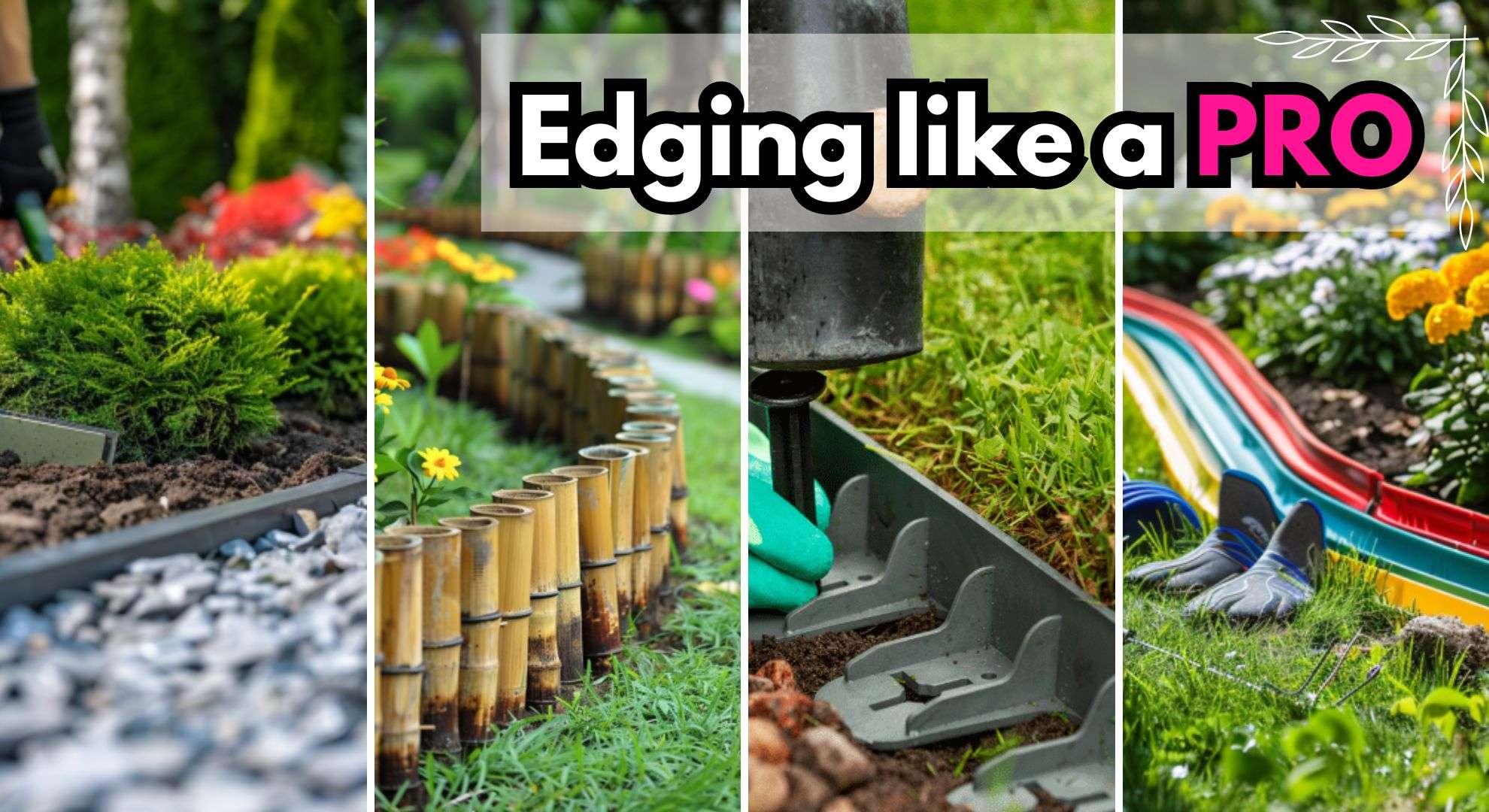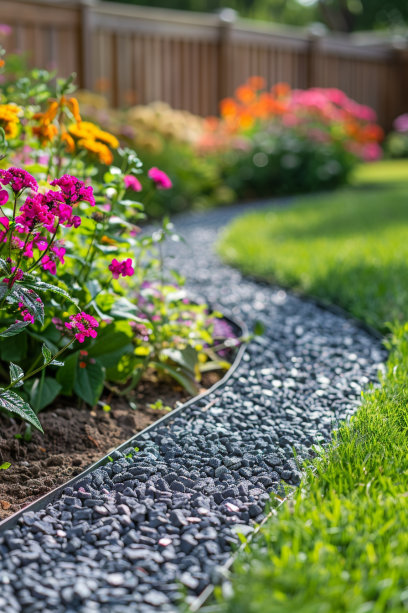Lawn edging might be one of the most overlooked elements of garden design, but it’s also the most important.
You can find your style, from budget materials to nice and comfortable.
Here are 9 lawn edging ideas to take your garden to the next level.
1. Natural Stone Edging
Using natural stone edging will give your lawn a timeless stylish look, perfectly complementing virtually any garden design.
Various types of stones can be used, including granite, slate or limestone.
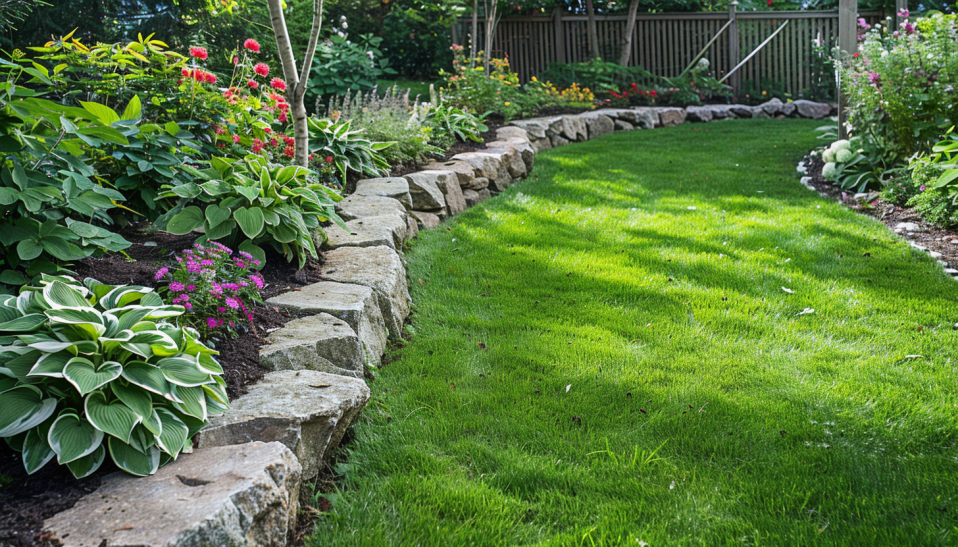
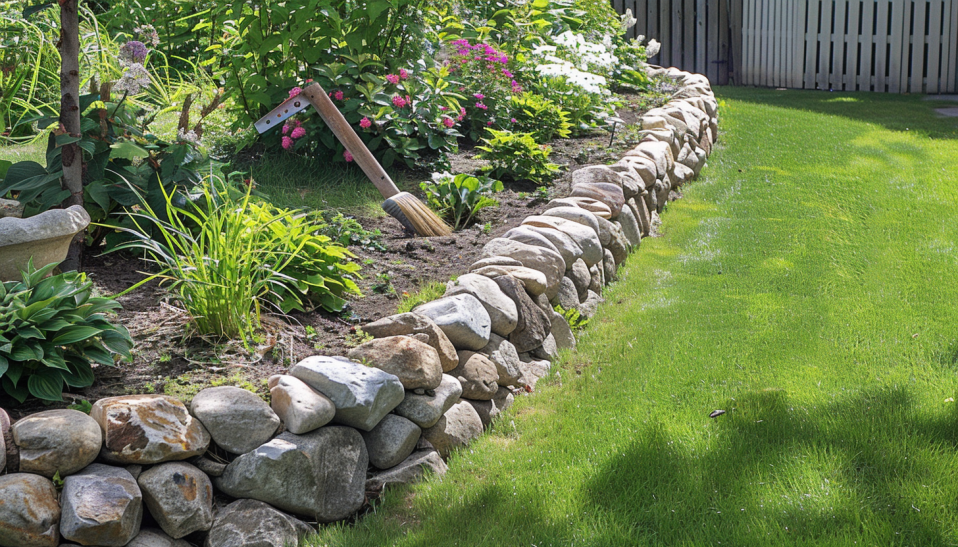
The diversity in the shapes and colors due to the natural character of your edging stones will add authenticity and charm to your lawn.
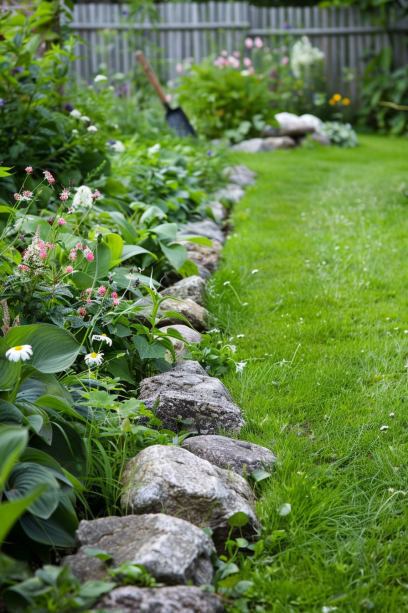
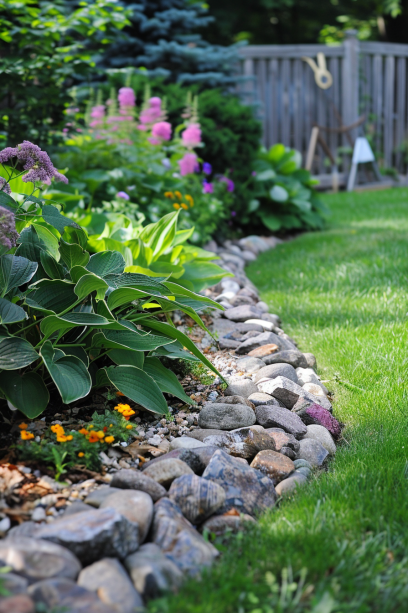
2. Brick Edging
Another classic option for edging is brick.
Laying bricks along the edges of your garden adds a more formal and structured look. Bricks can also be laid in different patterns such as herringbone or basketweave, which adds visual interest.
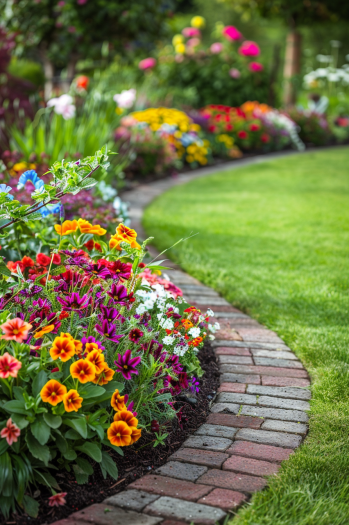
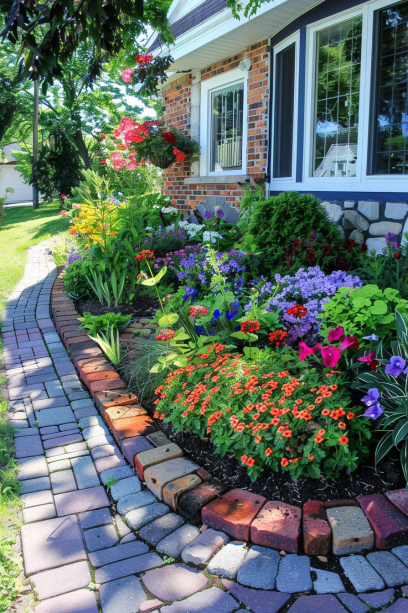
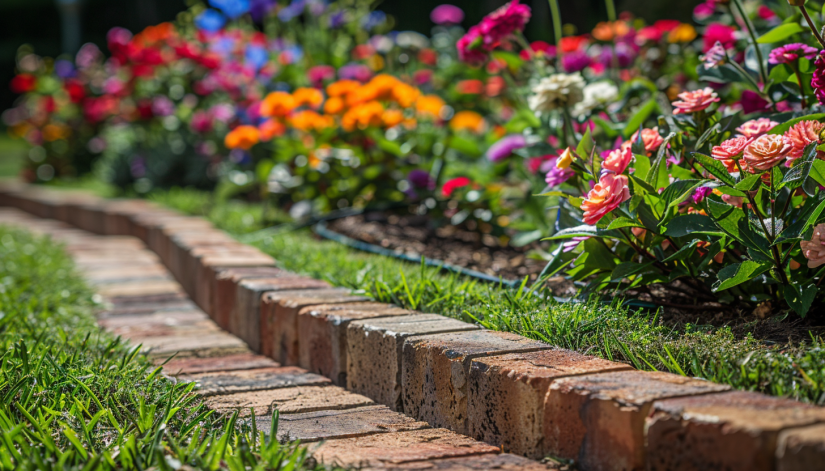
They are a hardy material and will stand up to the weather for years.
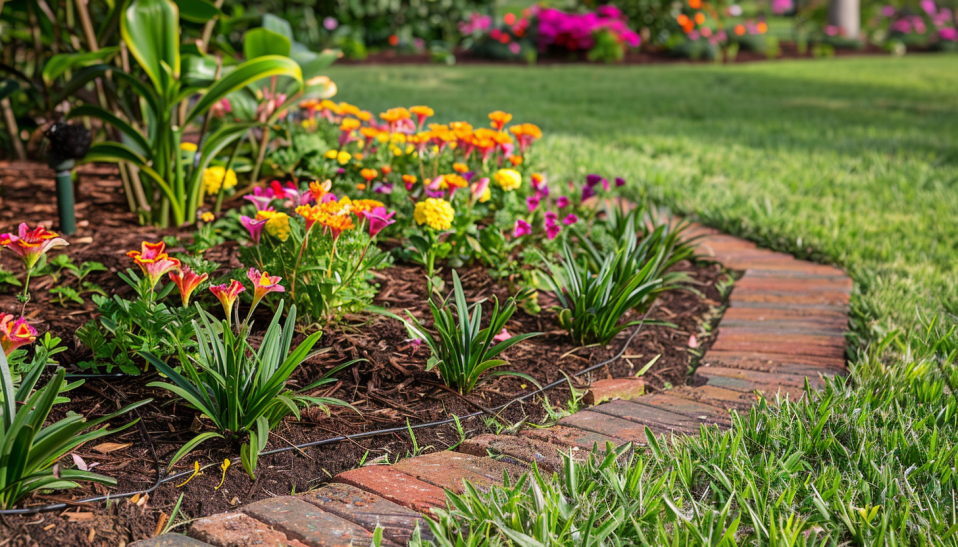
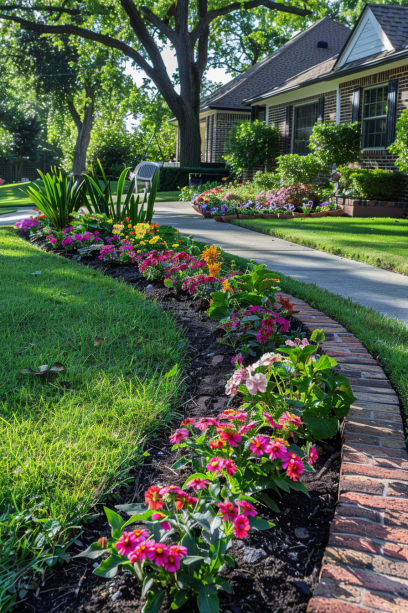
3. Wooden Log Edging
An unconventional way to border your garden is to use logs or timbers.
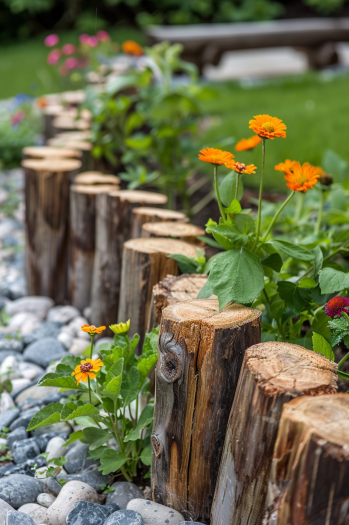
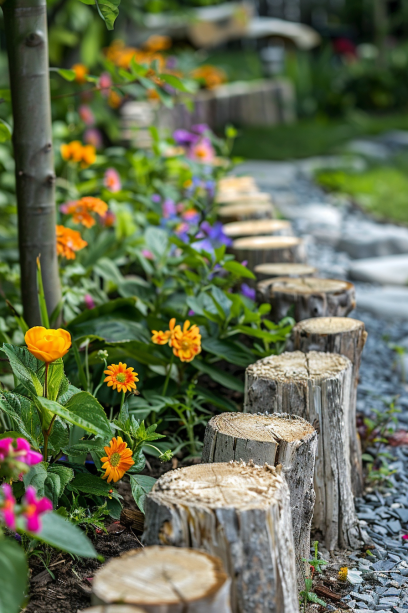
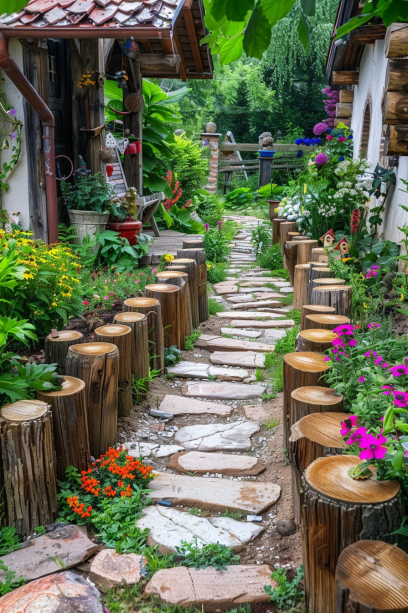
You can position them vertically or horizontally to create a pretty, natural-looking border.
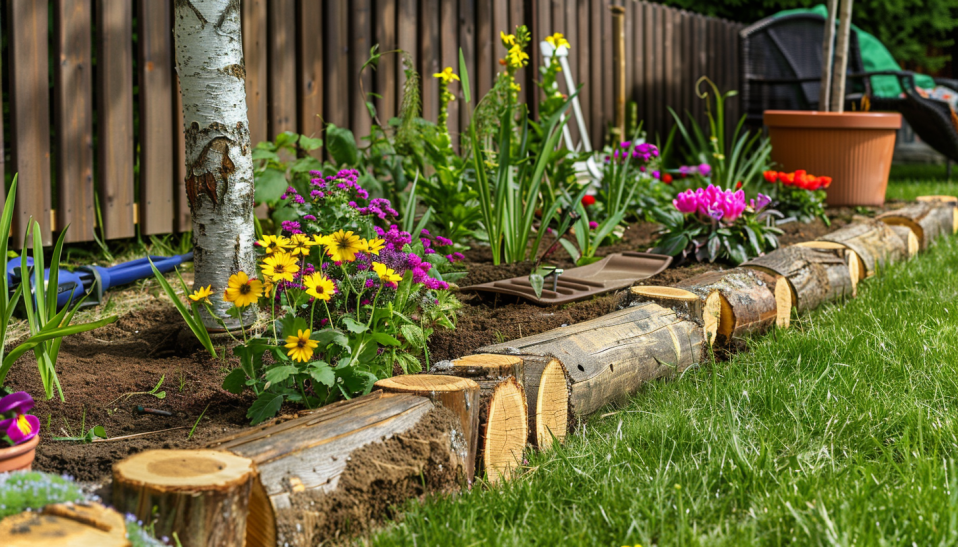
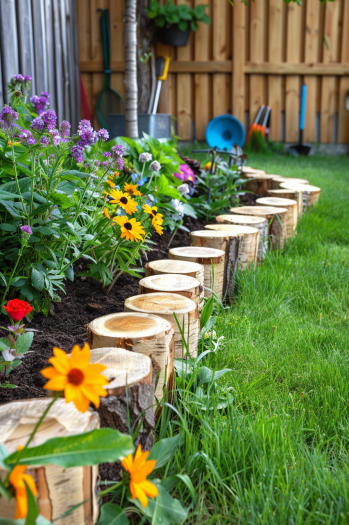
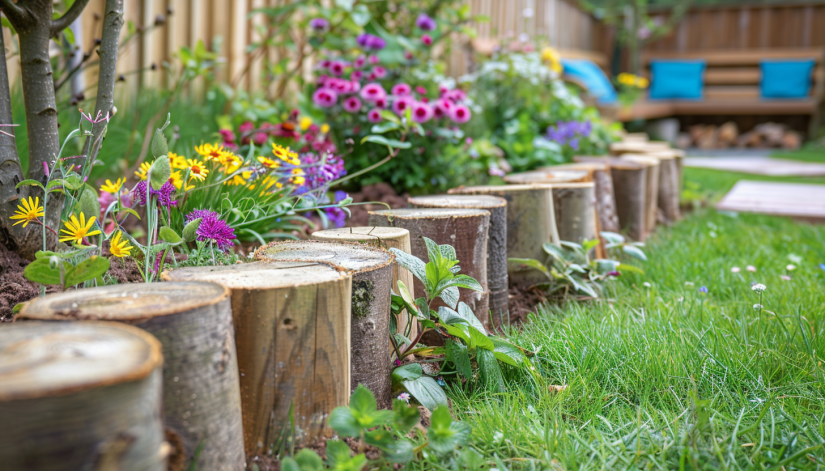
4. Metal Edging
Metal edging provides a modern finish to your garden.
Steel, aluminium or corten steel are the most popular choices as they are more durable than plastic and easier to maintain.
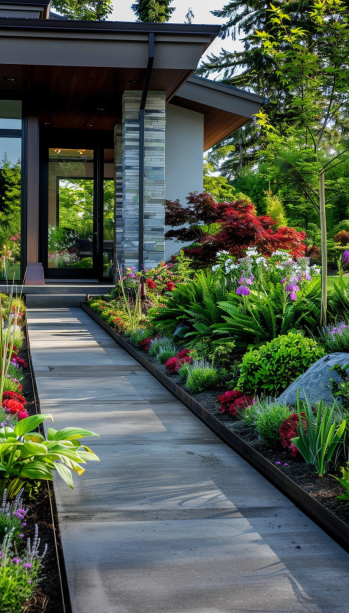
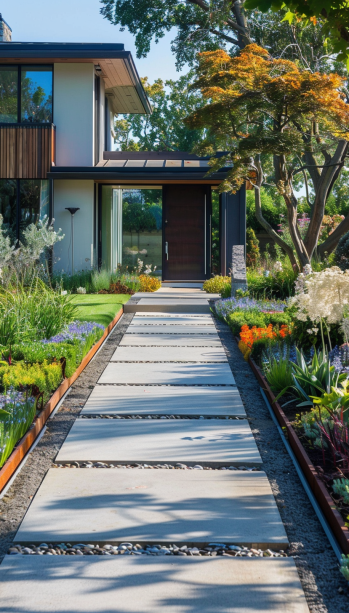
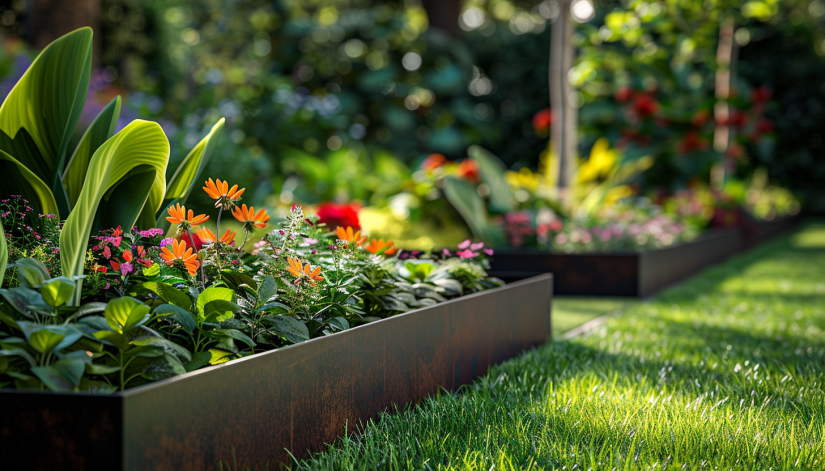
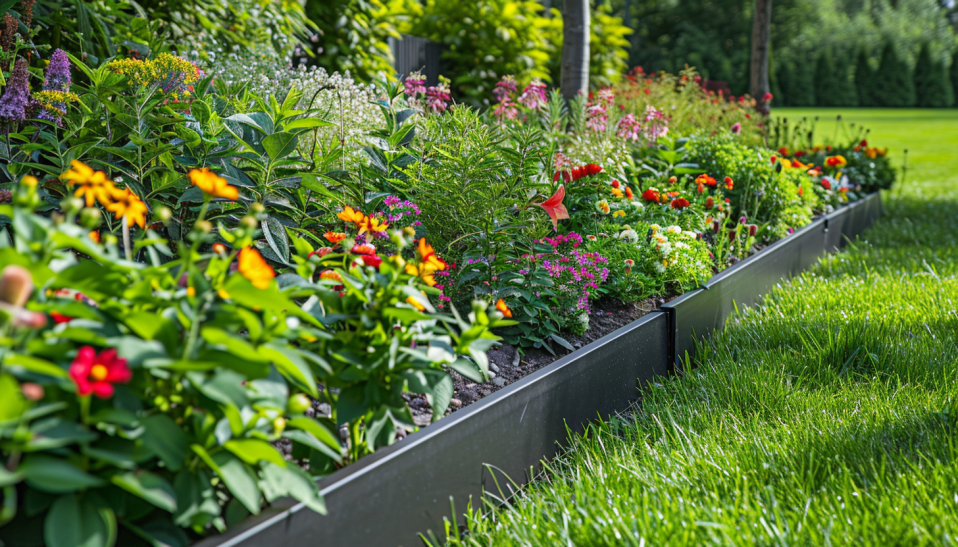
Clean, sharp lines can be achieved that delineate areas within the garden, adding a degree of sophistication.
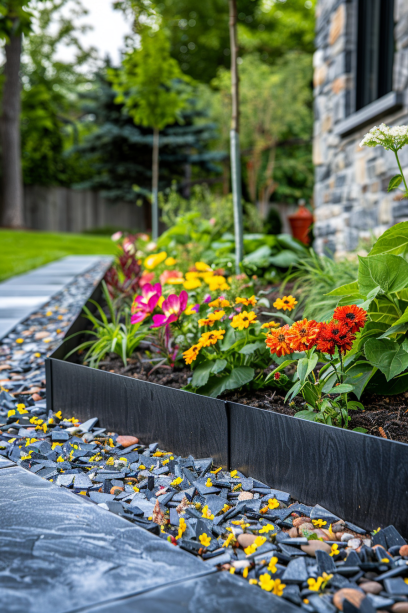
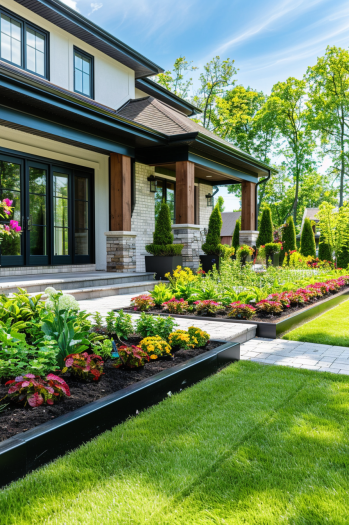
5. Plastic Edging
Plastic edging, on the other hand, is a smart and inexpensive solution to define your lawn areas.
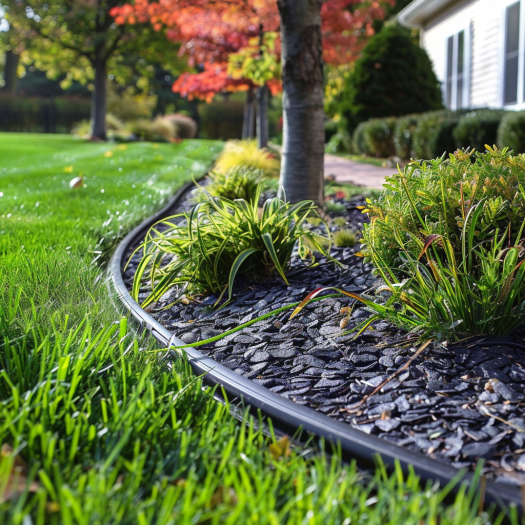
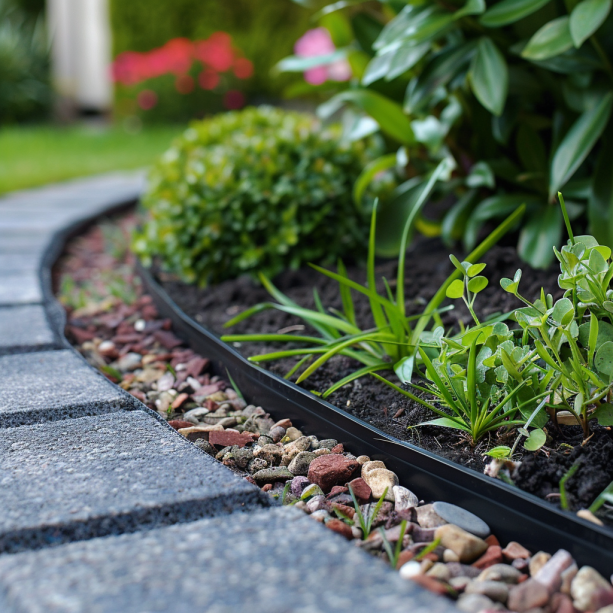
It is easy to install and bend to the desired shape of your garden.
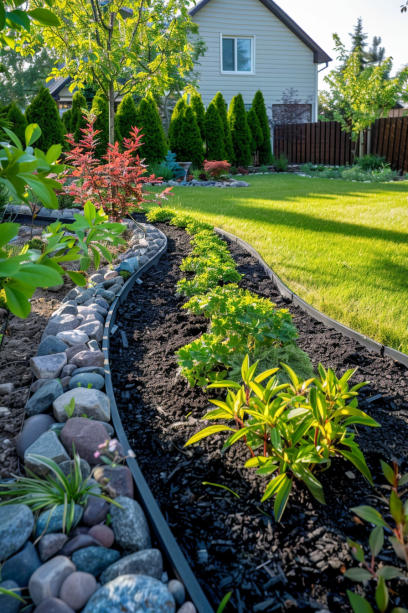
Available in different styles and colors, plastic edging can mimic the look of more expensive materials while staying within budget.
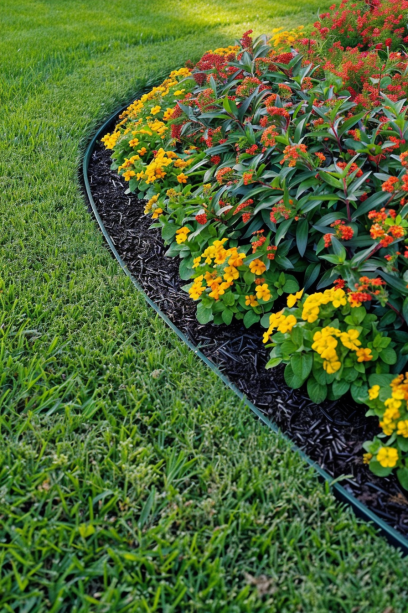
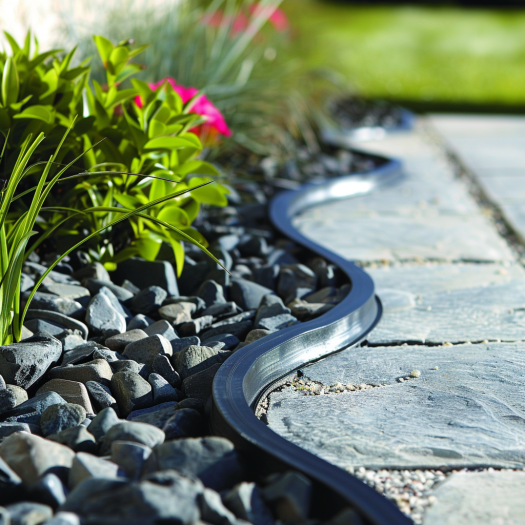
6. Concrete Edging
Strong and versatile, concrete edging can be moulded into straight lines, curved arcs, or elaborate patterns, while stamped or stained concrete can also add texture and colour.
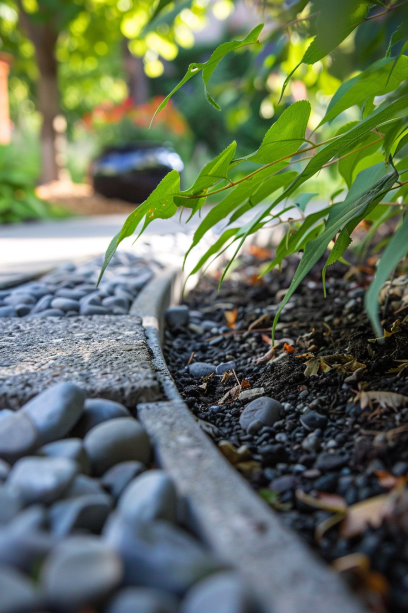
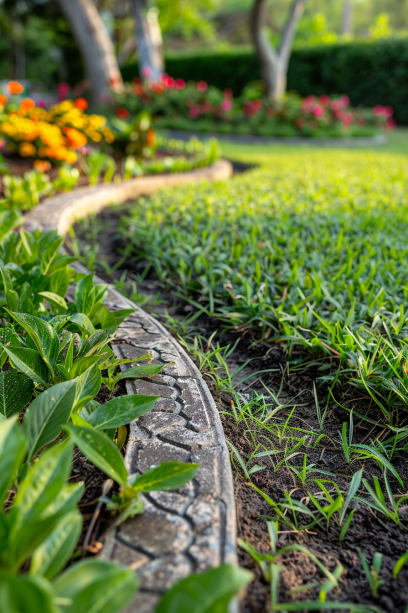
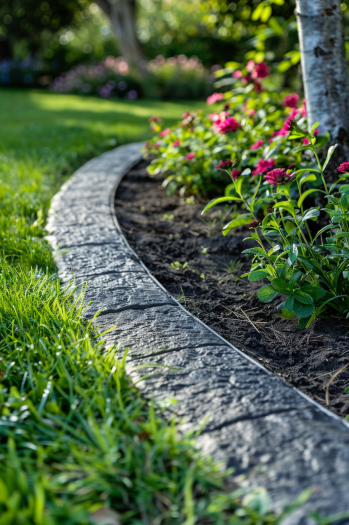
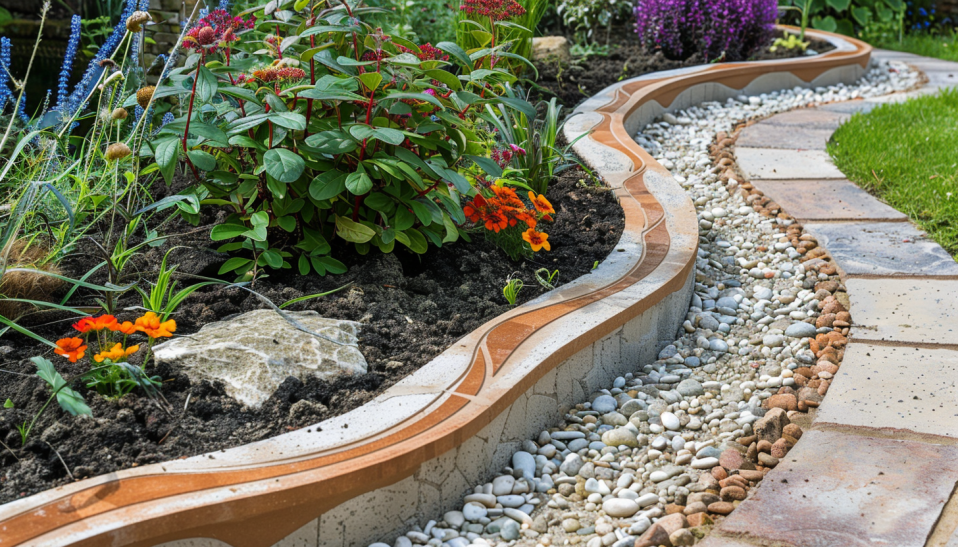
7. Living Edging
A type of edging that makes use of plants or shrubs to draw a natural boundary around your lawn is known as living edging.
For example, low-growing hedges, ornamental grasses or groundcover plants may serve as your demarcation while providing additional greenery and texture to your lawn.
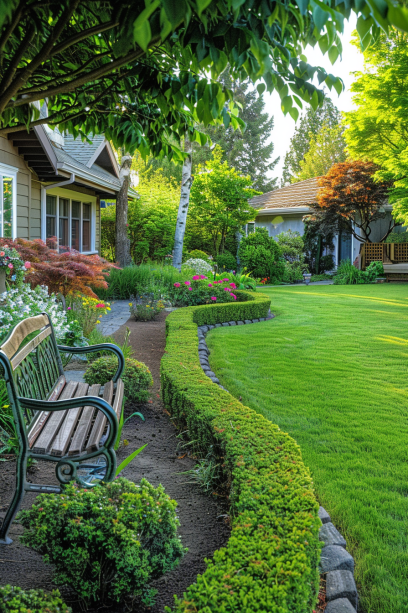
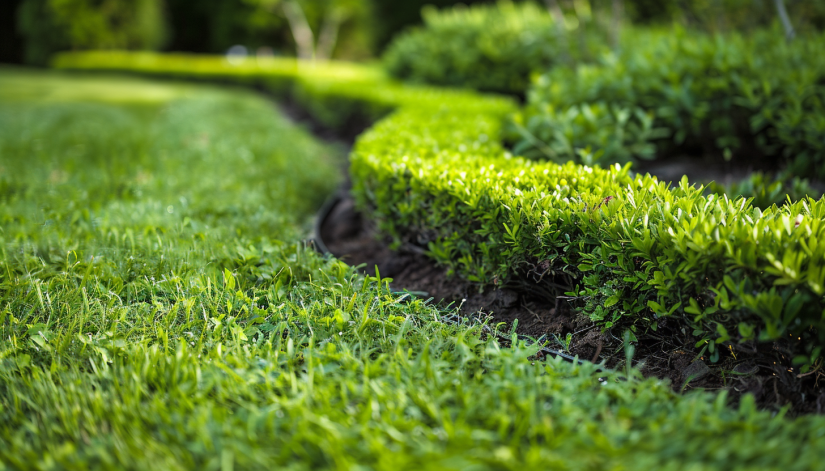
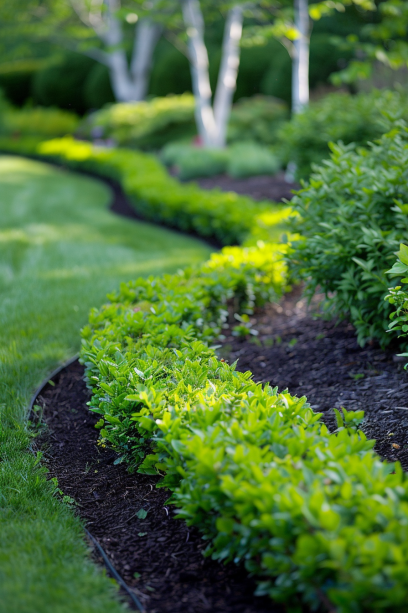
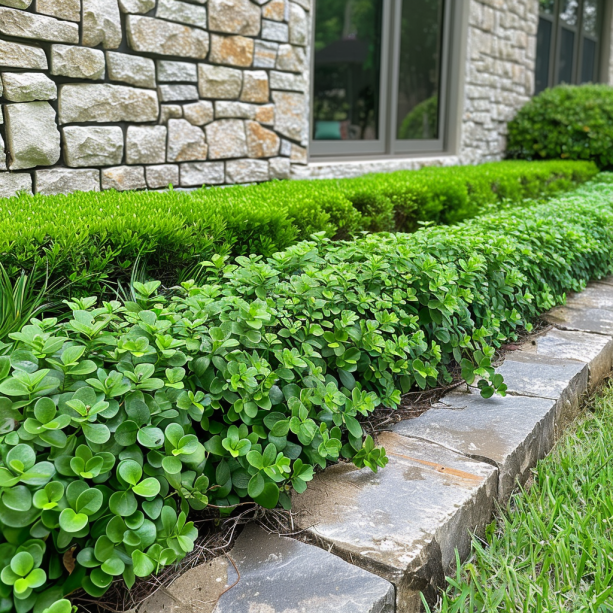
8. Gravel or Pebble Edging
Gravel or pebbles are a good and stylish material for low-maintenance lawn edging.
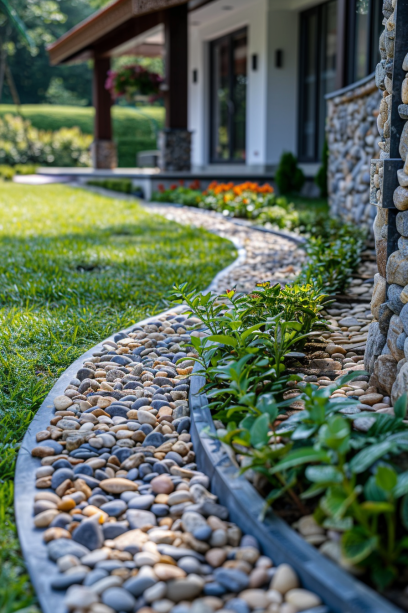
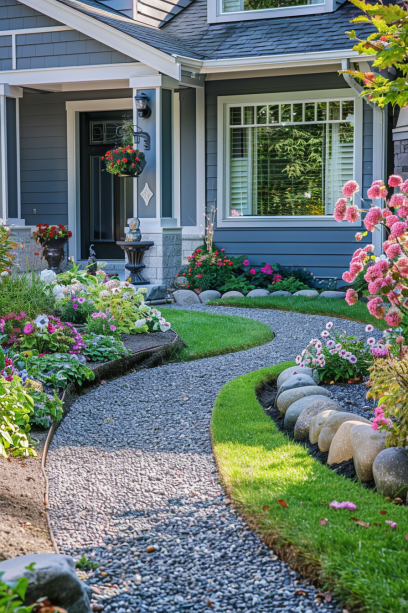
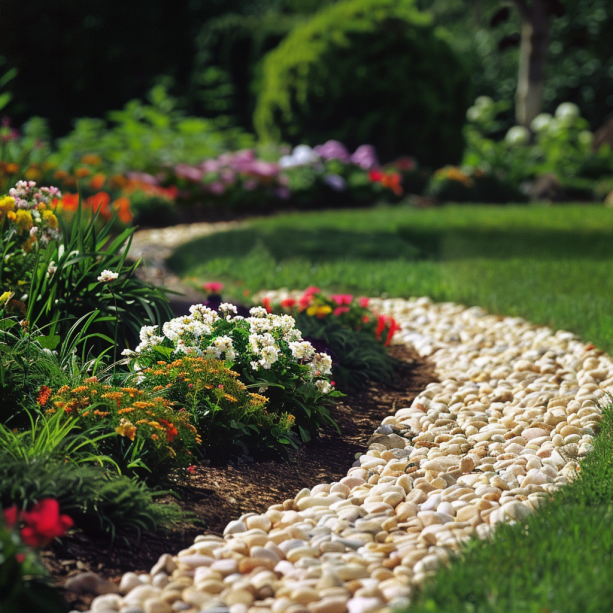
You can use different colours and sizes to complement your garden design.
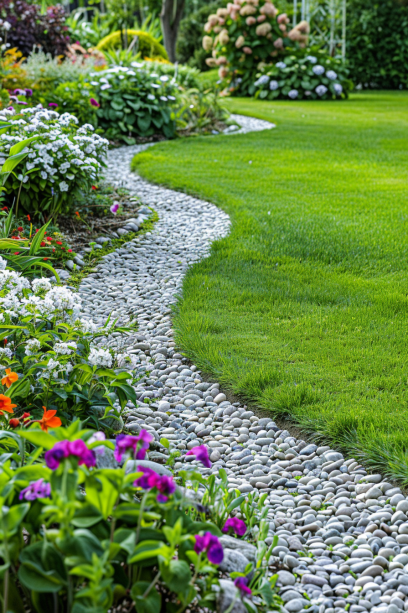
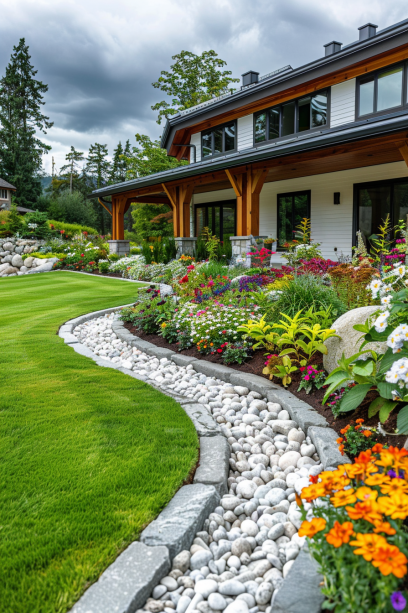
They also make an excellent border for pathways and garden beds.
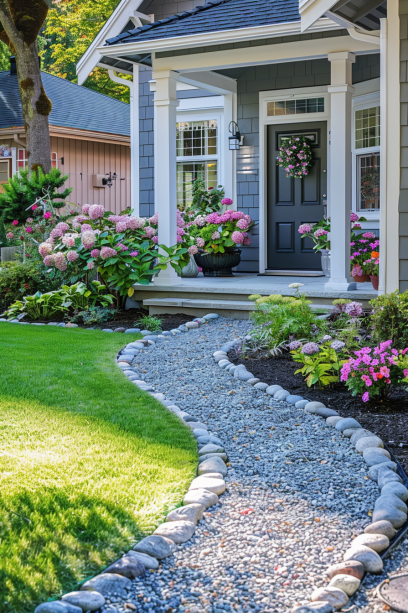
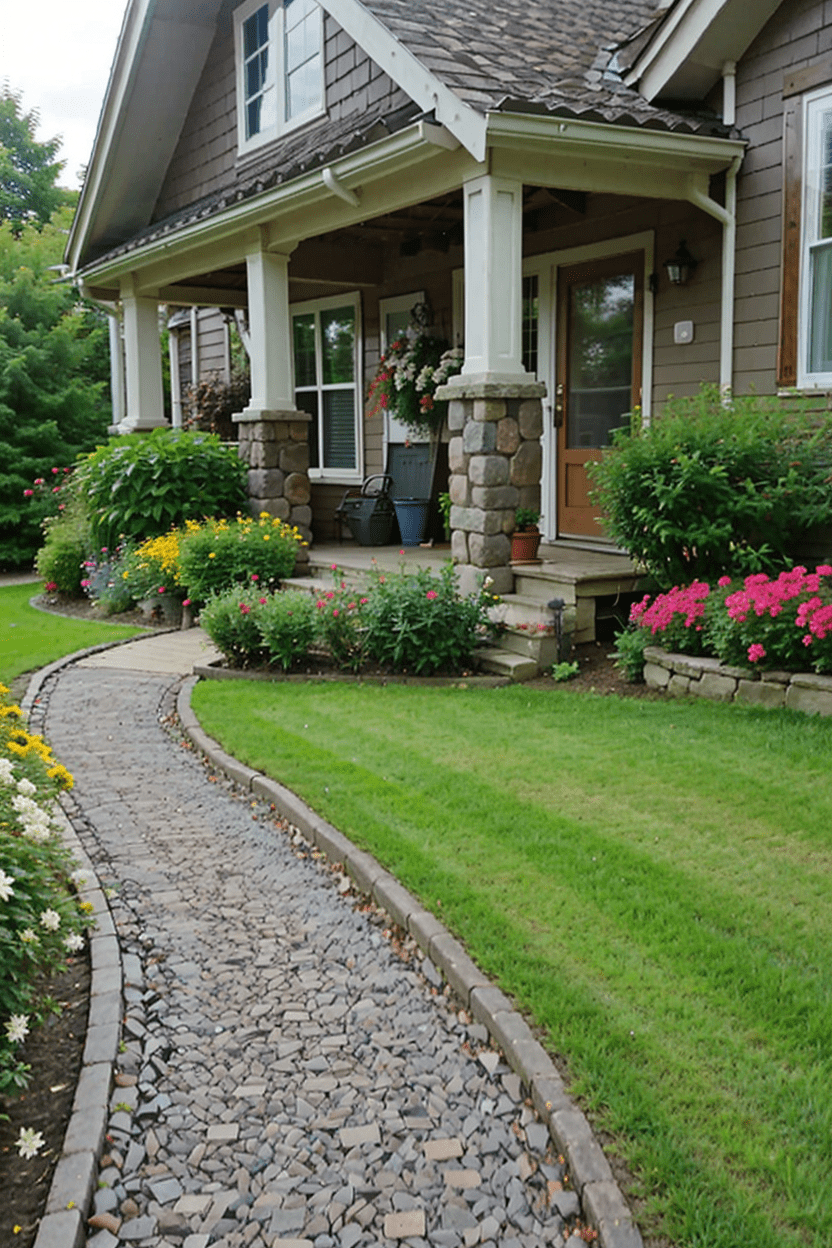
9. Rubber Edging
Another environmentally friendly and more practical alternative is the rubber edging.
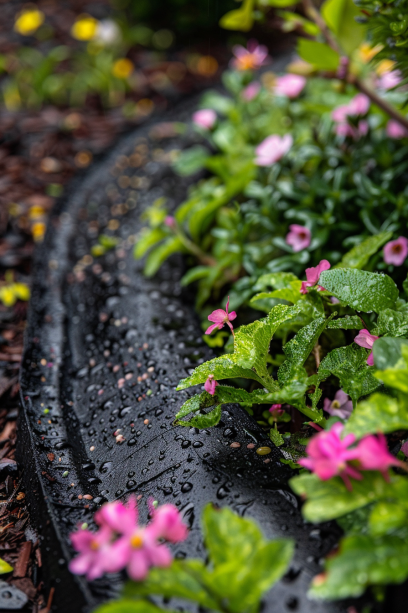
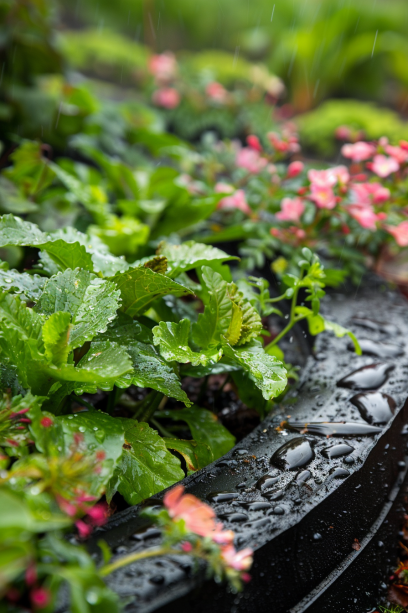
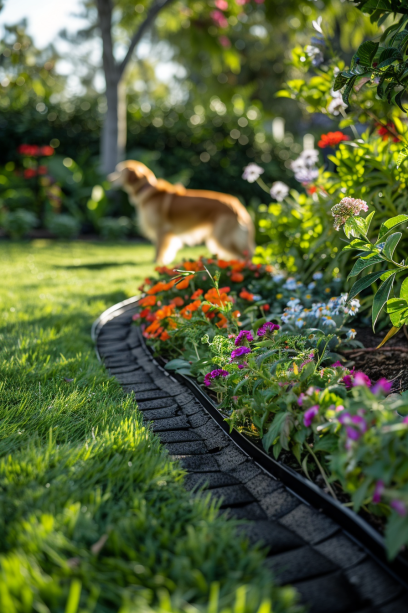
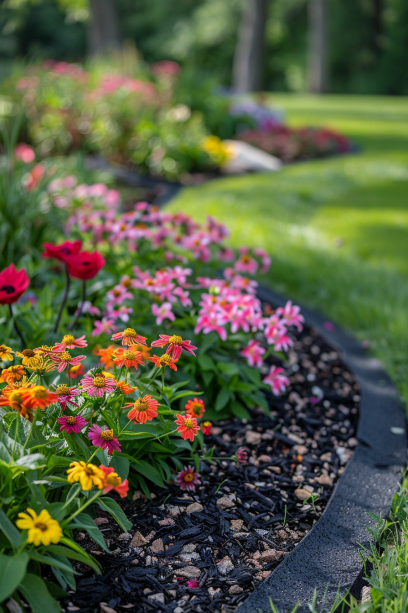
Types of Lawn Edging Materials
1. Natural Stone
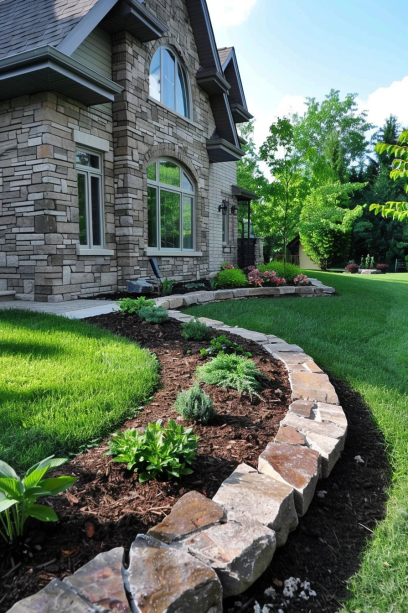
Types of Stone
Flagstone: A flat stone that’s great for paving patios. It’s also good for lawn edging and has irregular shapes that create a natural organic look.
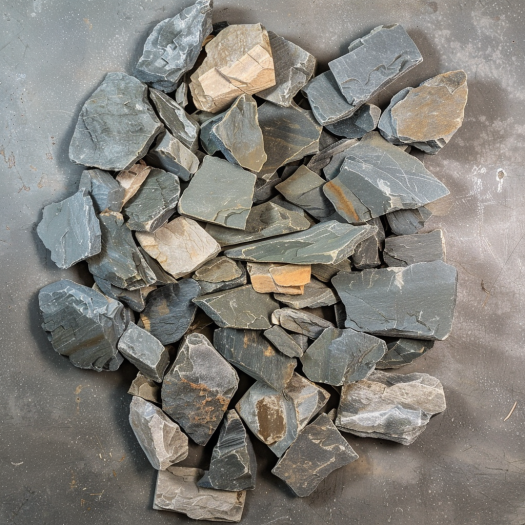
Cobblestones: Because they’re round and smooth, they’re best for a traditional or rustic garden, and they work well if you have a lot of foot traffic.
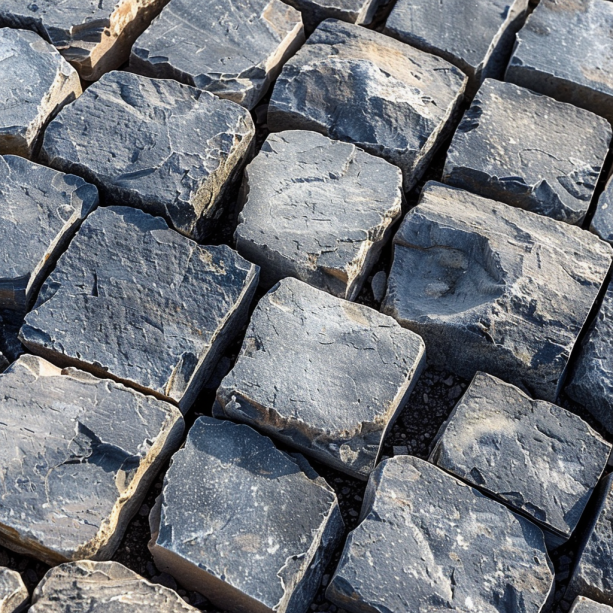
Slate: Smooth and beautiful, with lots of colourstriations, you can give your garden a sleek sophisticated look.
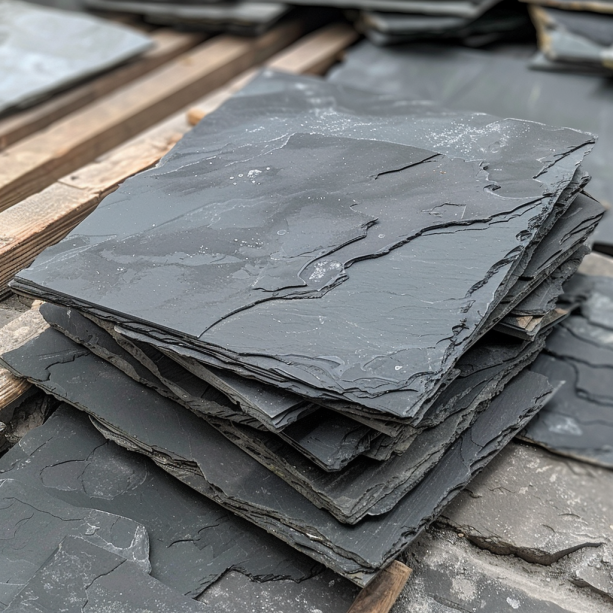
Pros:
- Durability: Natural stone is incredibly long-lasting and can withstand various weather conditions.
- Aesthetic Appeal: Offers a natural and timeless look that blends seamlessly with garden landscapes.
- Low Maintenance: Once installed, it requires minimal upkeep.
Cons:
- Cost: Can be expensive relative to other edging materials.
- Installation Difficulty: Requires professional installation or heavy DIY work.
Design Ideas:
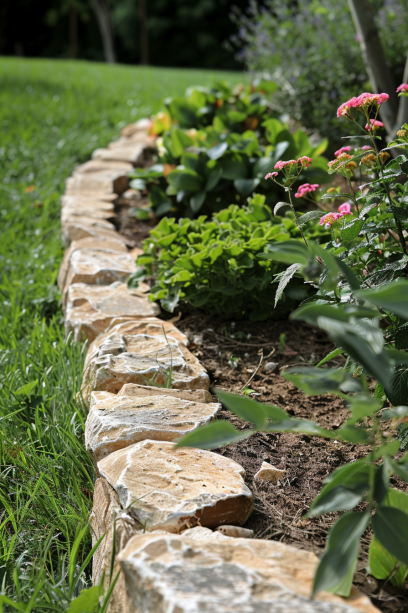
Curved Stone Pathways: Soft curves with stone create a flowy and organic look.
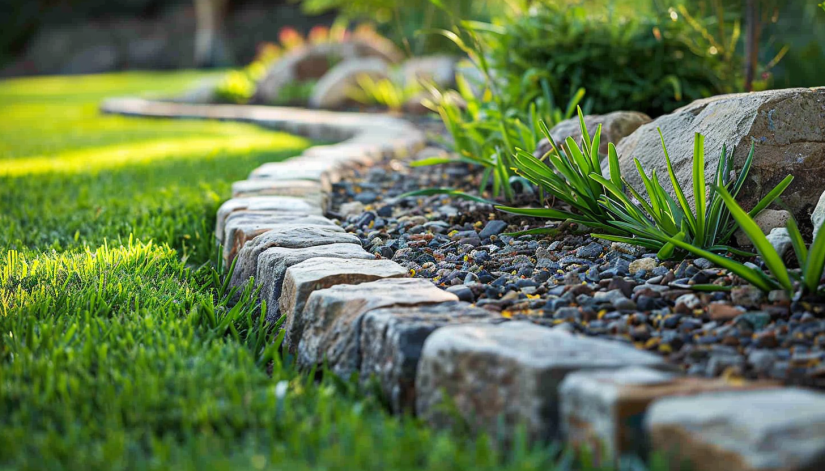
Raised stone edges: For added dimension and depth, set your stones on edge to raise the edge of your garden.
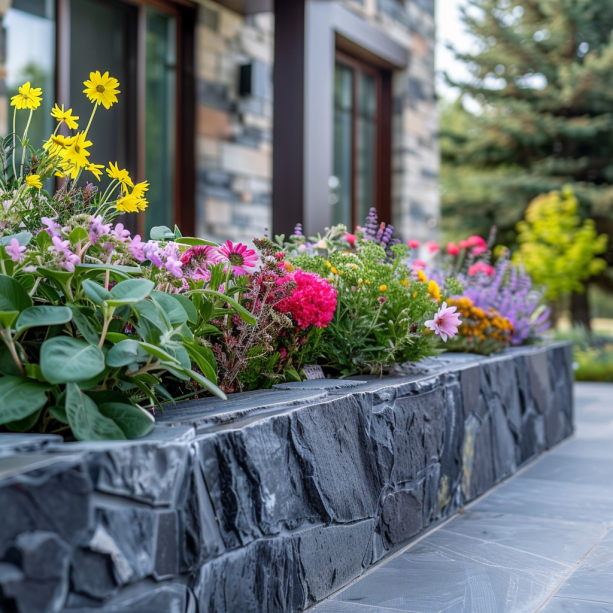
Combination with Plants: Interspersing plants between stones can create a natural, blended appearance.
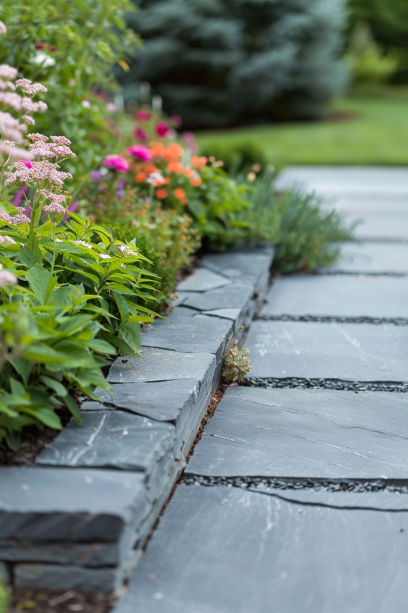
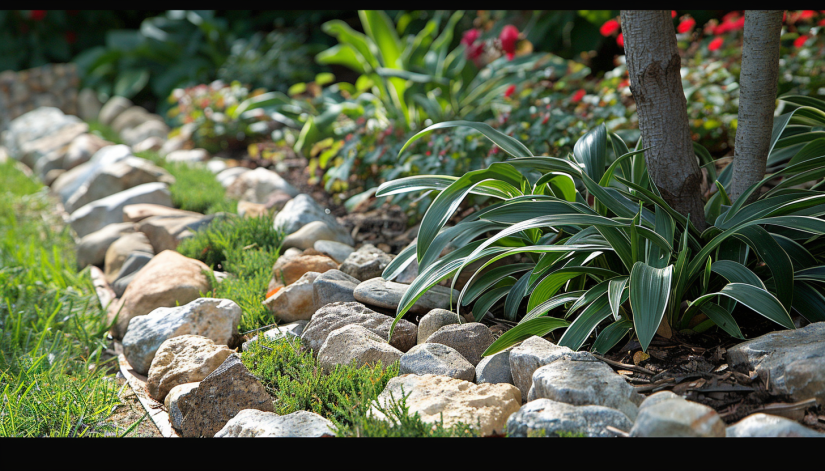
2. Brick
Varieties
Clay Bricks: The red bricks that are most commonly used in older buildings. The colours are warm and rustic.
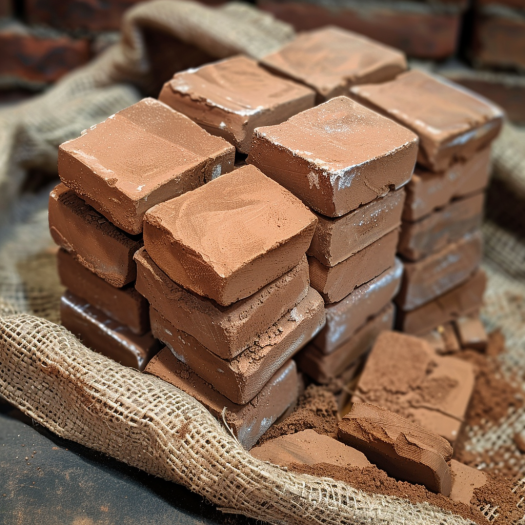
Concrete Blocks: Cement, available in a wide variety of colours and sizes, is less permeable than clay and often more durable.
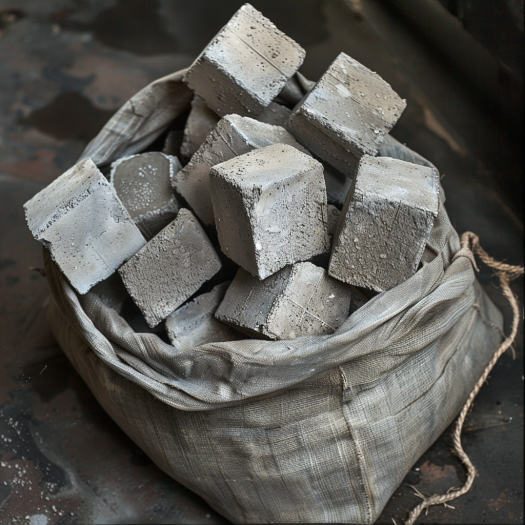
Reclaimed bricks: Characterful, reused bricks that are usually greener.
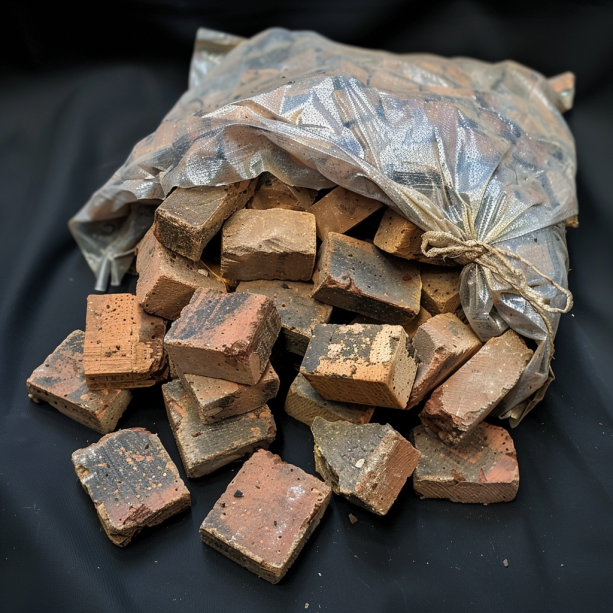
Pros:
- Traditional Appearance: Bricks offer a classic and timeless garden look.
- Durability: Bricks are strong and can last many years.
Cons:
- Time-Consuming Installation: Laying bricks can be labor-intensive.
- Potential for Weed Growth: Poorly installed brick edges can become breeding grounds for weeds.
Design Inspirations:
Straight Lines: The simplest and cleanest installation, ideal for modern gardens.
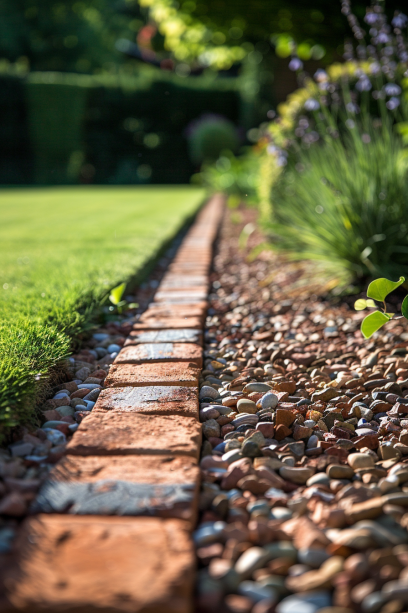
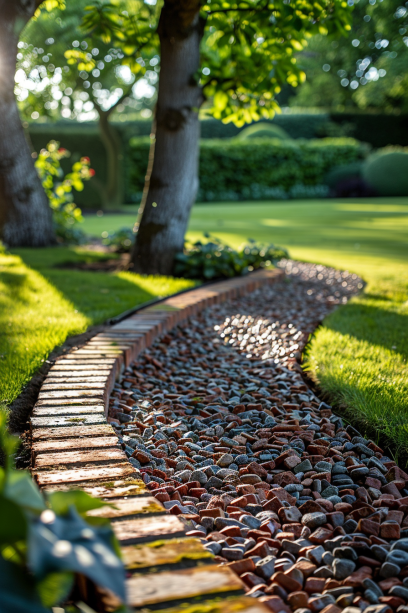
Herringbone Patterns: A more intricate and visually interesting pattern.
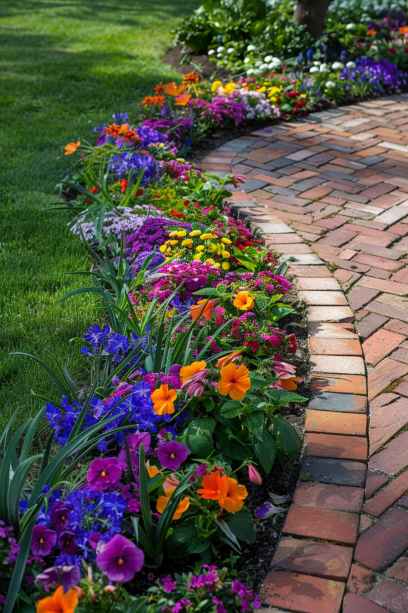
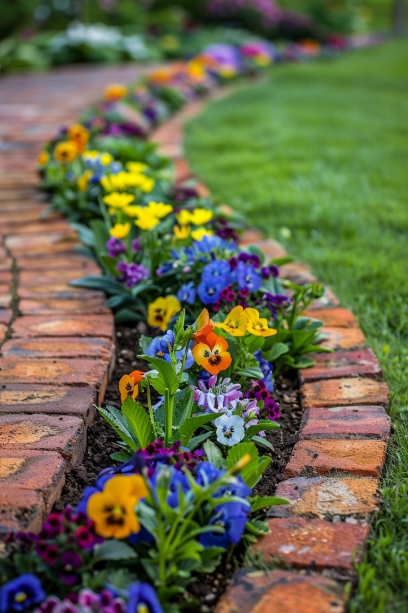
Concrete Blocks Arrangements: Can create a more modern, more formal look.

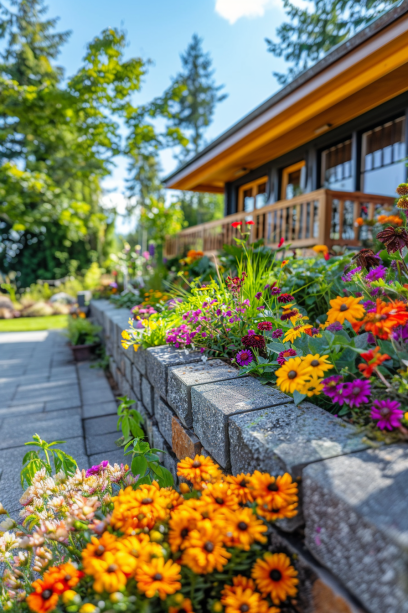
3. Wood
Types of Wood:
Cedar: This wood is naturally resistant to rot and insects. It’s great for garden projects.
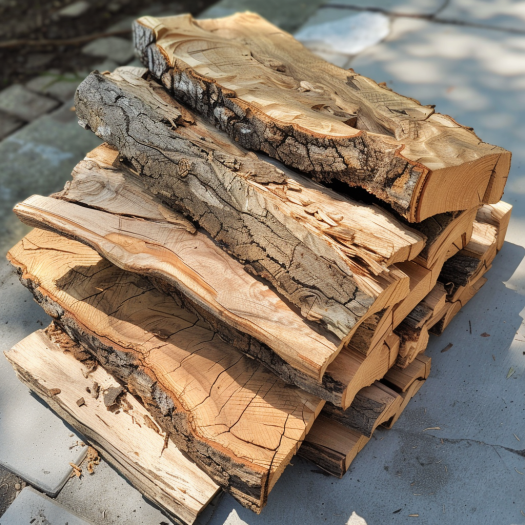
Redwood: Another rot-resistant wood, though typically more expensive.
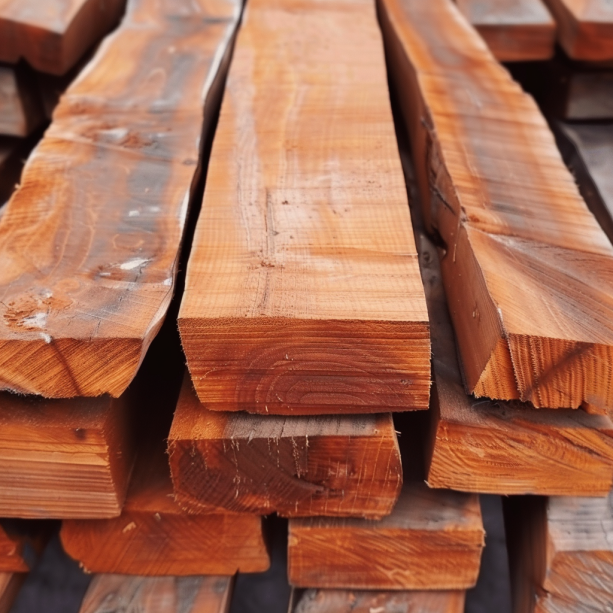
Treated Pine: Treated to resist rot and pests, it’s the most affordable, but not as strong as cedar or redwood.
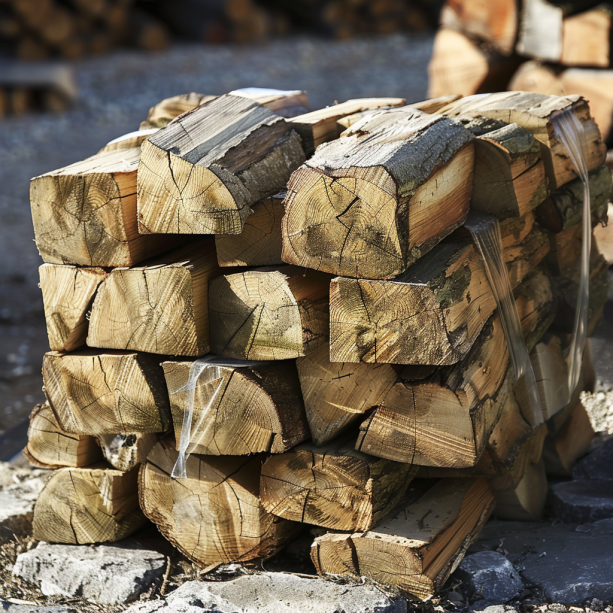
Pros:
- Natural Look: Wood blends effortlessly into natural landscapes.
- Cost-Effective: Generally less expensive than other materials.
Cons:
- Weathering: Wood can weather and degrade over time if not properly maintained. 😔
- Maintenance: May require staining or sealing to prolong life.
Ideas:
Logs: Using logs vertically or horizontally for a rustic look.
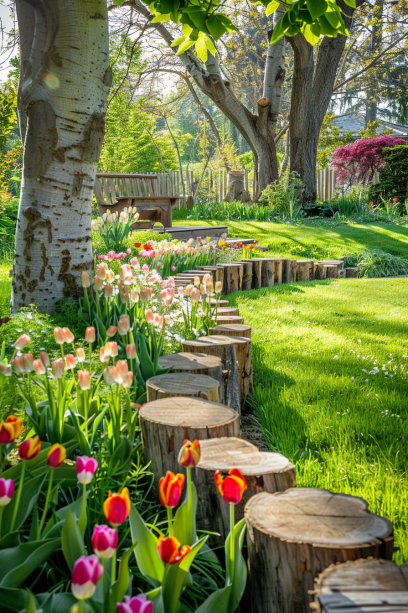
Timber: Larger pieces of wood placed end-to-end for a continuous, solid edge.
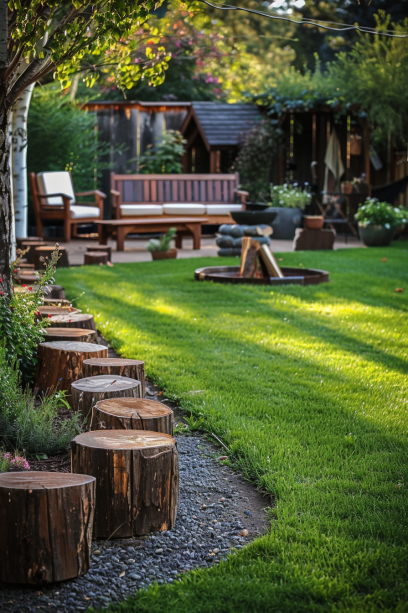
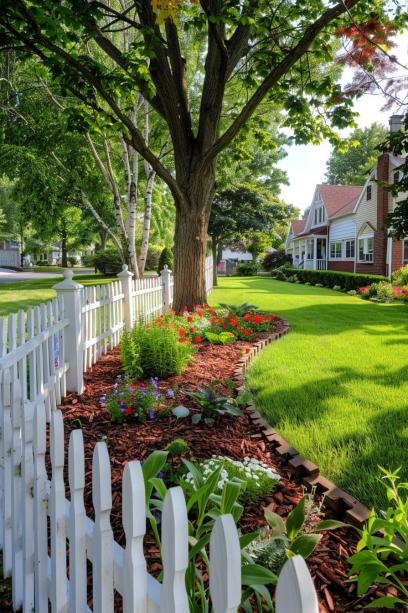
Staked wood: Skinny sticks driven into the ground to form a low fence or boundary.
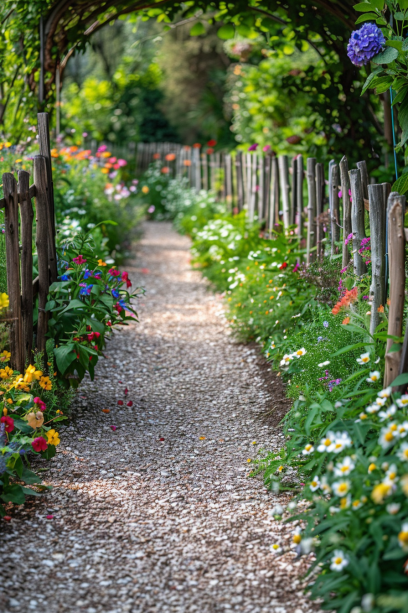
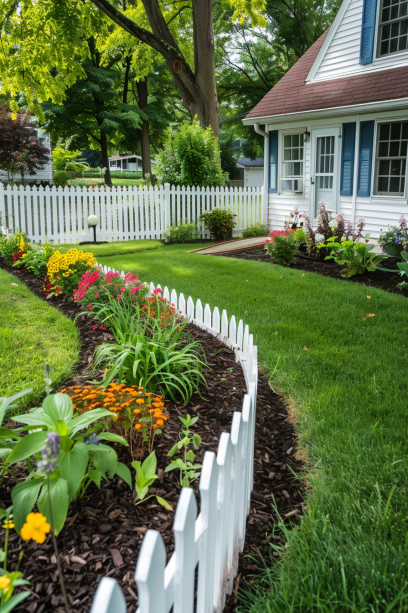
4. Metal
Types of Metal
Steel: Strong and durable, often galvanized for rust protection.
Aluminum: Lightweight and resistant to rust but not as strong as steel.
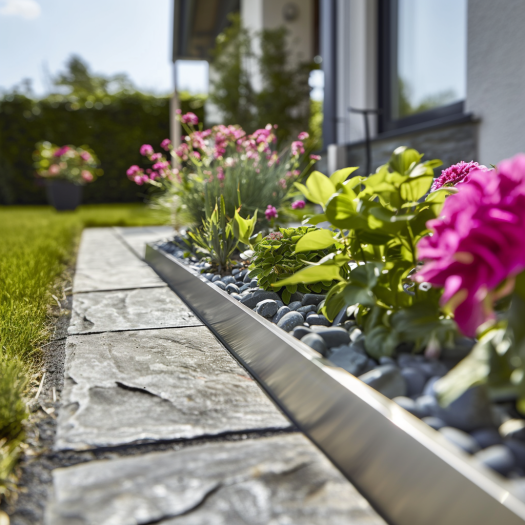
Iron: Offers a classic and robust look but needs maintenance to prevent rust.
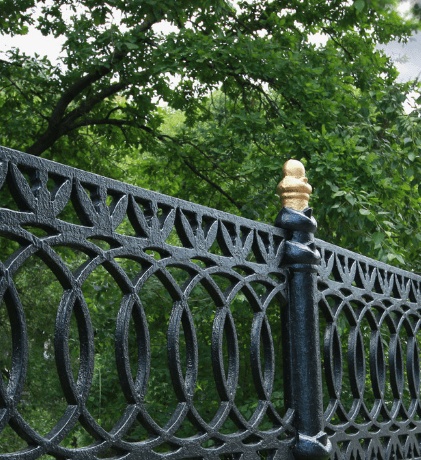
Pros:
- Modern Look: Metal provides a sleek and contemporary appearance.
- Longevity: Both steel and aluminum are long-lasting materials.
Cons:
- Potential for Rust: Particularly with iron or non-galvanized steel.
- Higher Cost: Metal can be more expensive than other materials.
Design Ideas:
Minimalist Straight Lines: Clean, unembellished edges perfect for modern gardens.
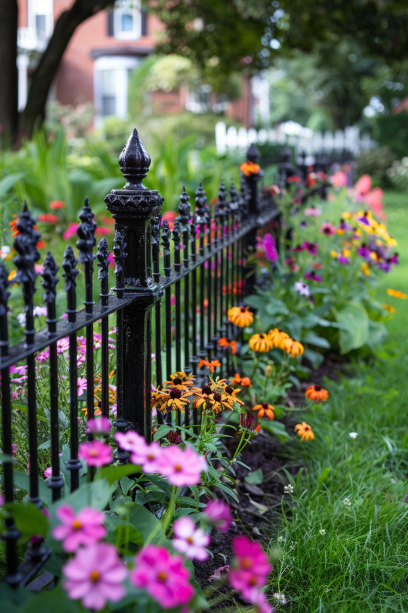
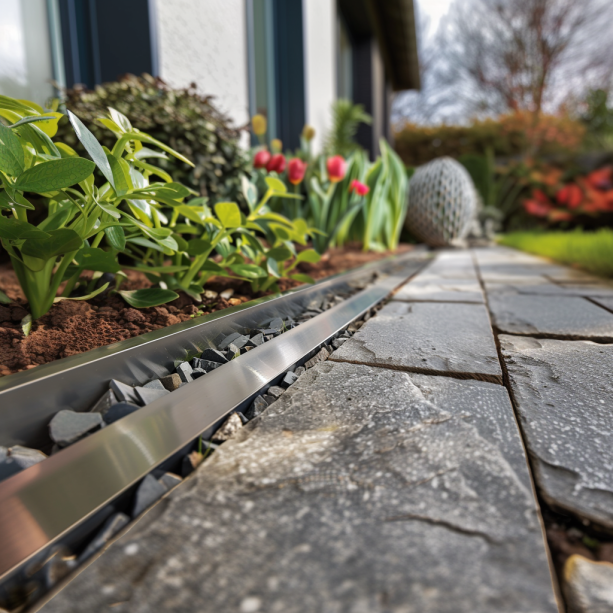
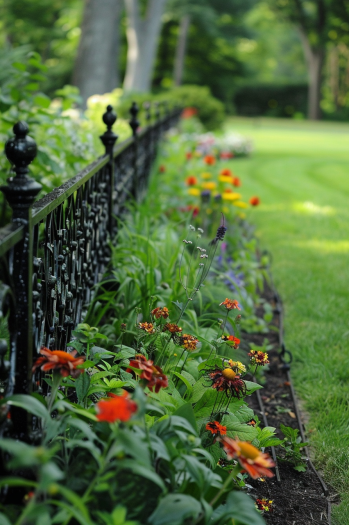
Custom Shapes: Metal can be bent into various shapes to fit any design.
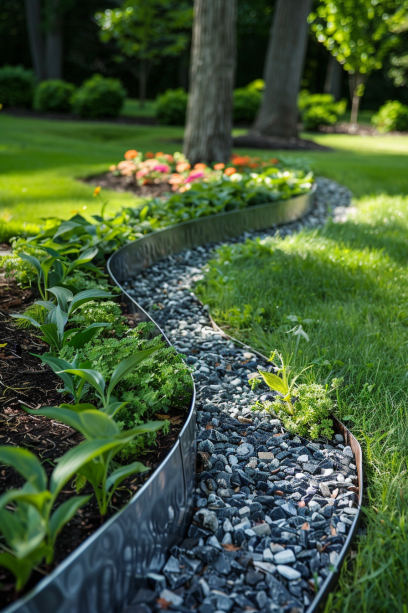
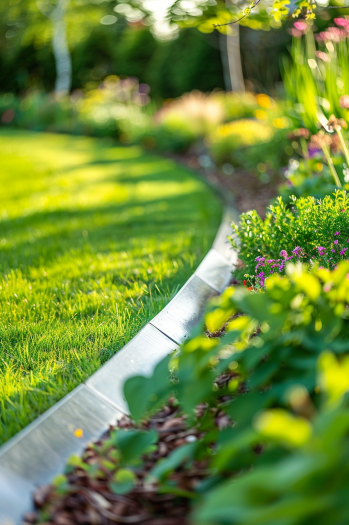
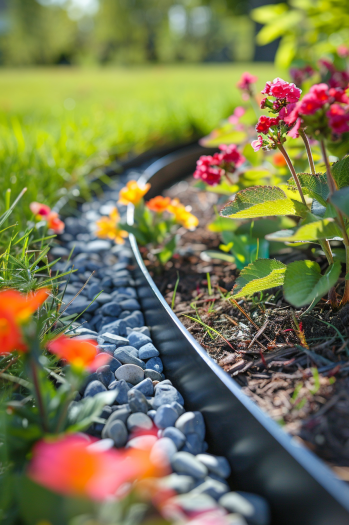
Powder-Coated Options: Available in numerous color options for added customization and protection.
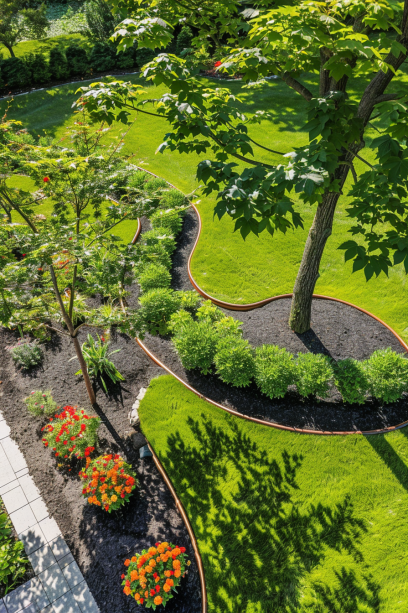
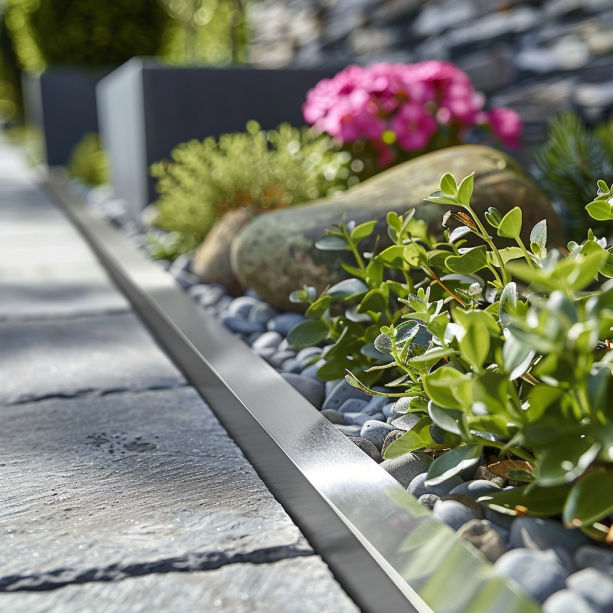
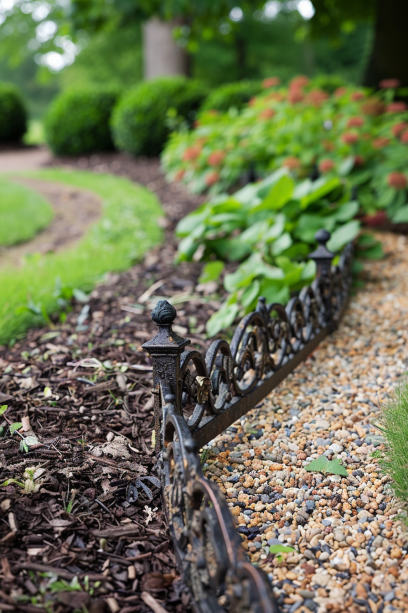
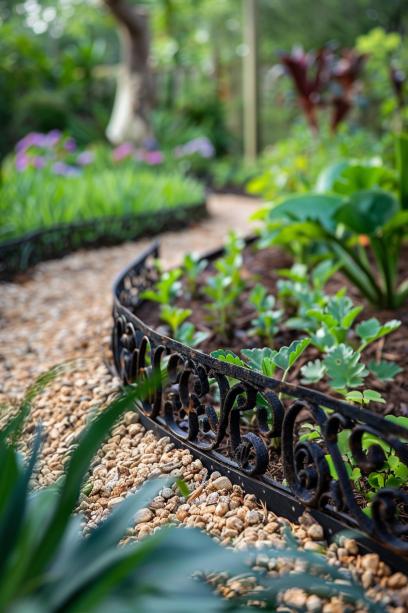
5. Plastic
Types of Plastic Edging
Roll-Edging: Flexible plastic that comes in rolls, easy to install and manipulate into curves.
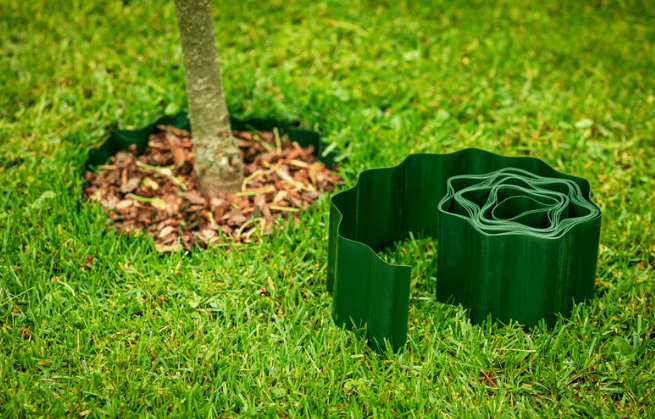
Decorative Plastic Barriers: Pre-formed plastic barriers with various decorative designs.
Pros:
- Cost-Effective: Affordable compared to other materials.
- Flexible: Easy to install and shape around complex garden designs.
Cons:
- Less Durable: Can be damaged more easily than other materials.
- Less Natural Look: Might not blend as seamlessly into natural landscapes.
Design Ideas:
Subtle Borders: Low-profile plastic borders that blend into the garden.
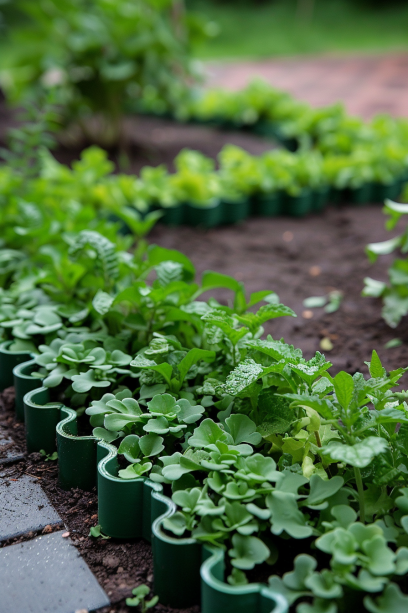
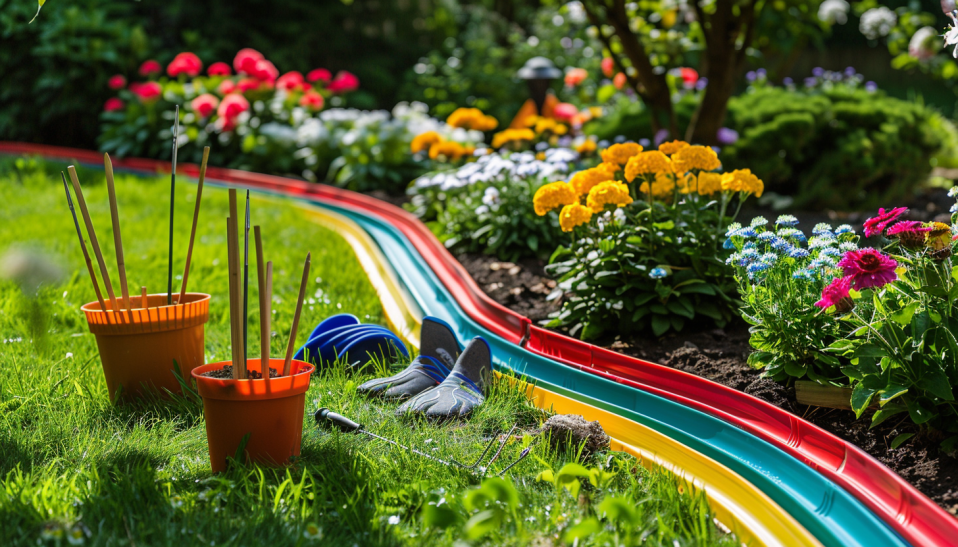
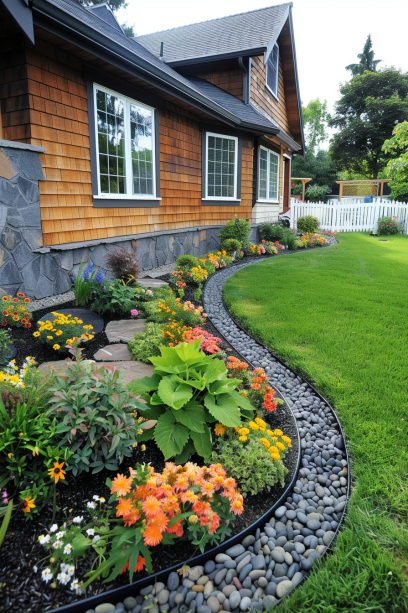
Bright Colored Edges: Use colorful plastic to add a playful touch.
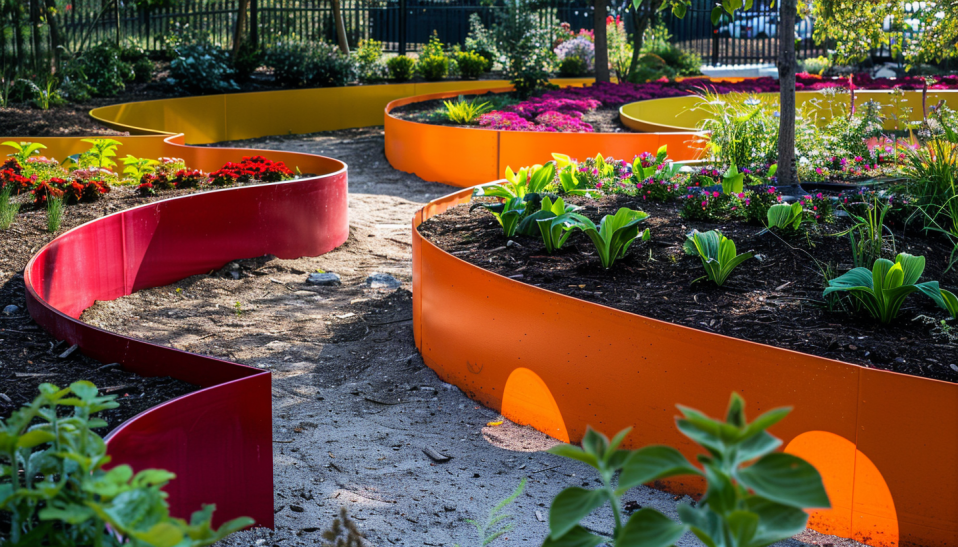
Interlocking Systems: Edging sections that fit together like puzzle pieces for a cohesive look.
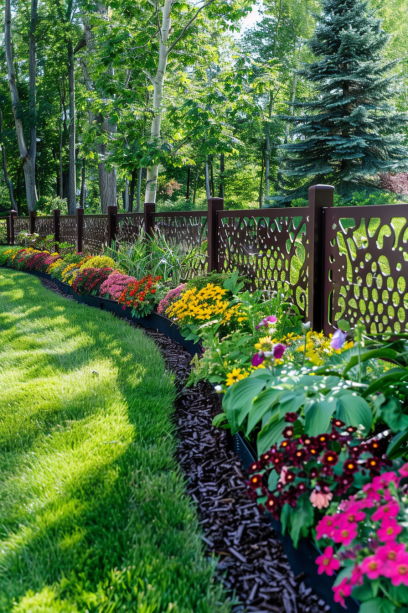
Budget-Friendly Options
Some creative lawn edging ideas on a budget can be very economical and produce stunning results.
Plastic Edging Rolls
Widely available at garden centers, plastic edging rolls are among the most budget-friendly options.
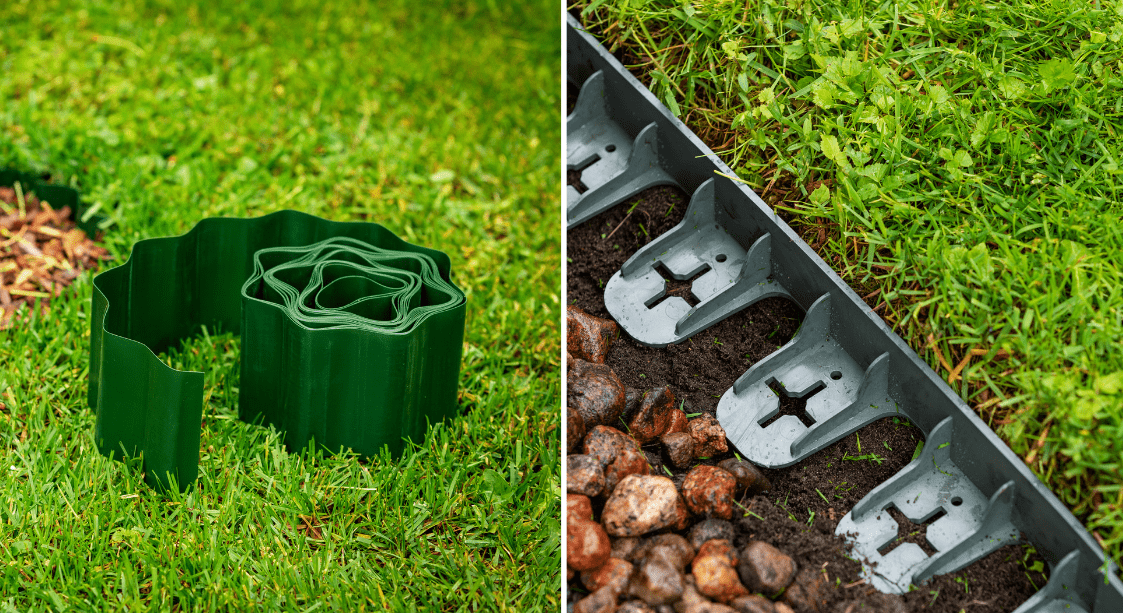
- How to: All you have to do is unroll it and lay it along the edge of your garden – secure it with either stakes or soil.
- Form and Function: These are created with texture and patterns that are available in a wide range of colours, and impersonate upmarket finishes such as stone or metal.
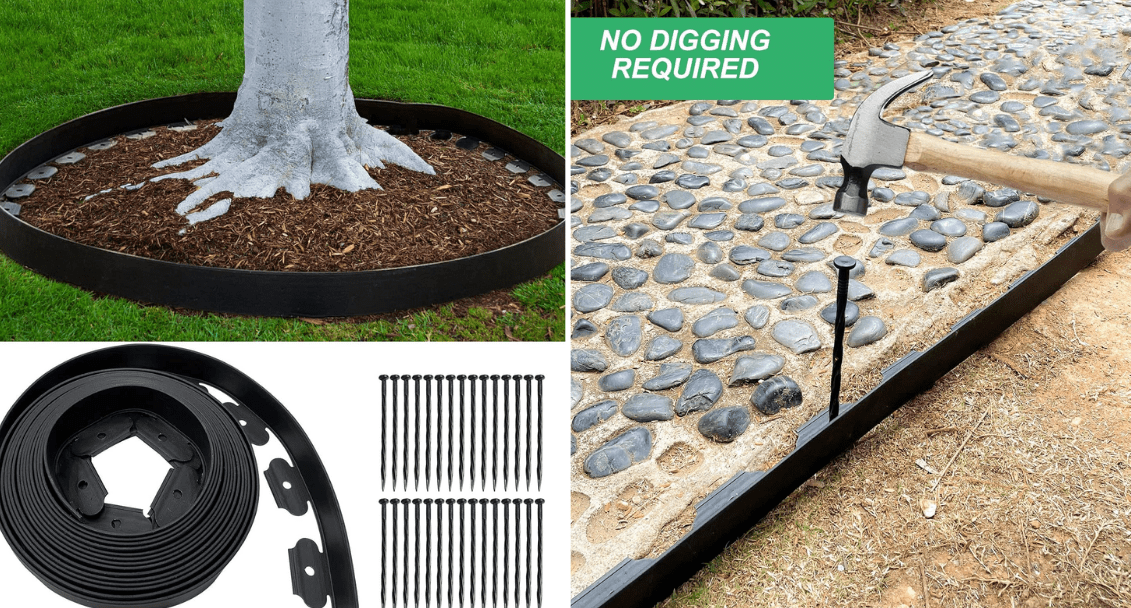
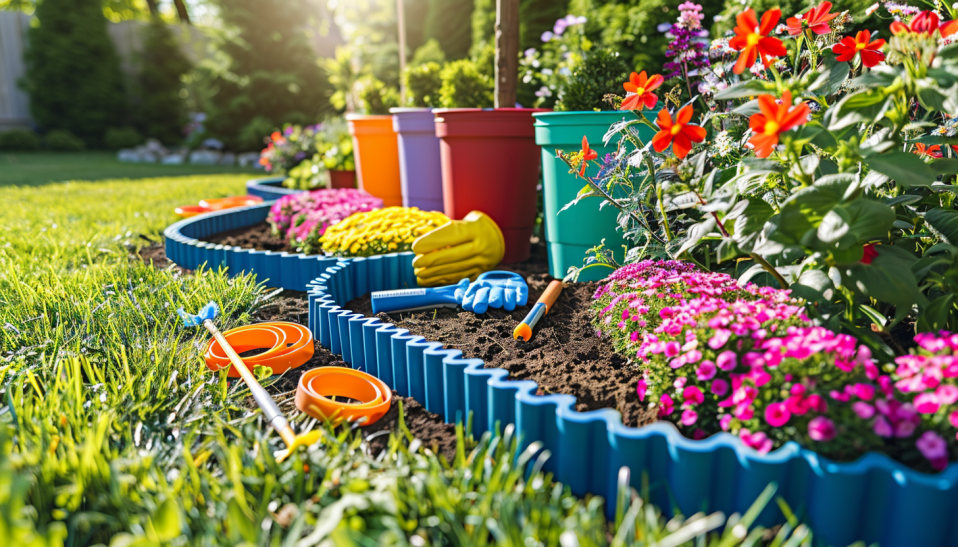
- Installation: Easy for DIYers, takes minimal time and effort.
Gravel or Mulch Trenches
Instead of a border of edging, use gravel or mulch to define the lawn from the garden beds.
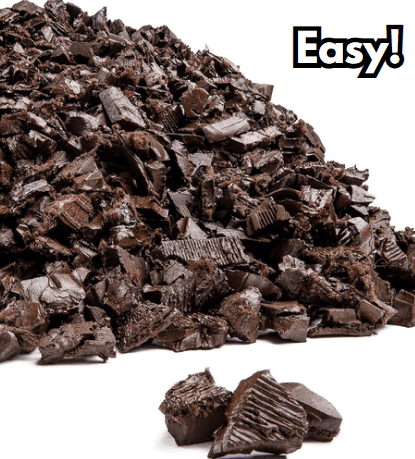
- How to apply: Dig a trench 3-4 inches deep and fill with gravel, pebbles or mulch.
- Benefits: Inexpensive, promotes drainage, and easy to replace or refresh as needed.

Concrete Paver Bricks
A clean edge can be created with concrete paver bricks, inexpensive and easily found.

- How to Use: Lay them end-to-end or stack them to create a raised border.
- Flexibility: Can be painted or stained to match your garden’s color scheme.
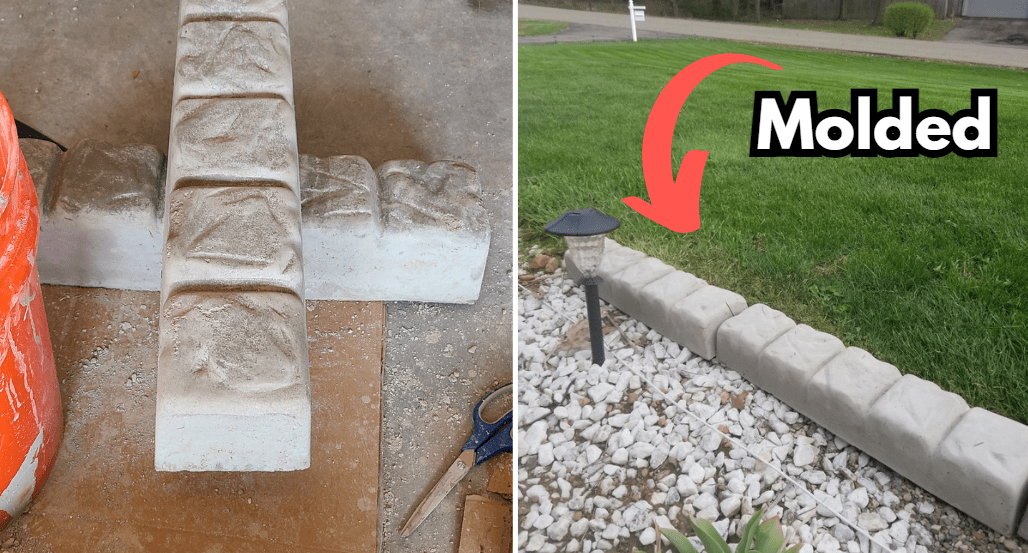
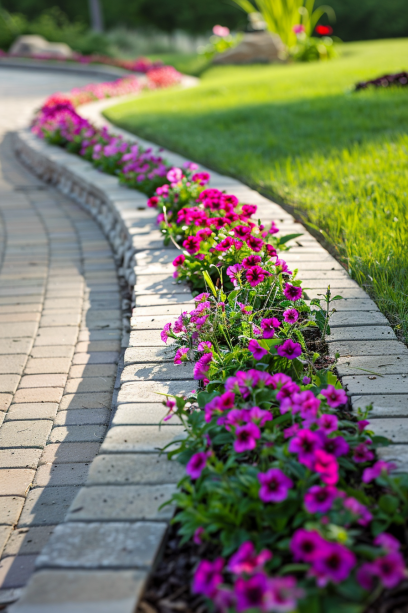
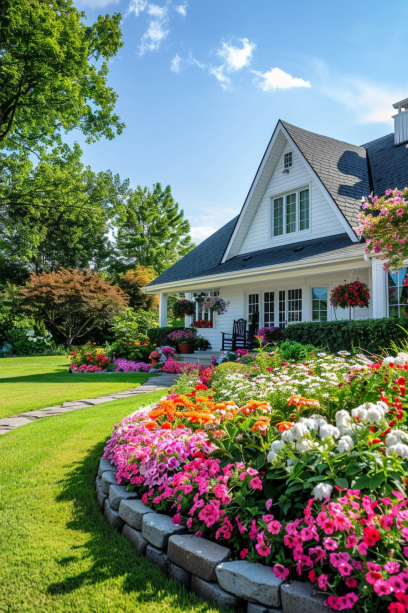
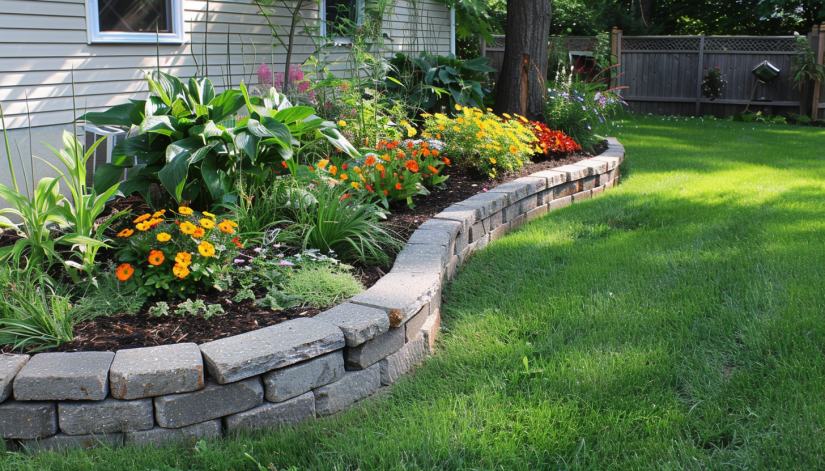
Eco-Friendly Solutions
Environmentally friendly gardeners look for ways to make lawn edges sustainable and minimise the use of natural resources.
Bamboo Edging: Bamboo grows back in a year and young shoots can be harvested sustainably, making it a highly renewable resource.
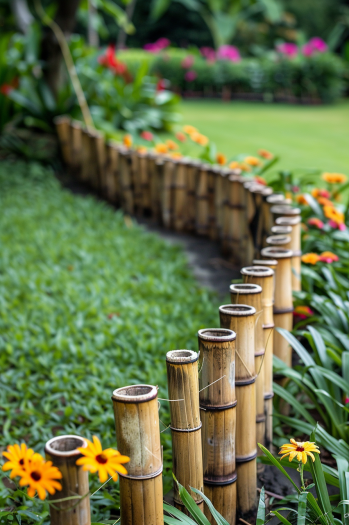
- How To: Plant a living bamboo fence at the edge of your landscape where you want to define a barrier. Tie or stake bamboo poles along the garden edge to hold in place.
- Appearance: Adds a rustic, natural look that blends seamlessly with greenery.
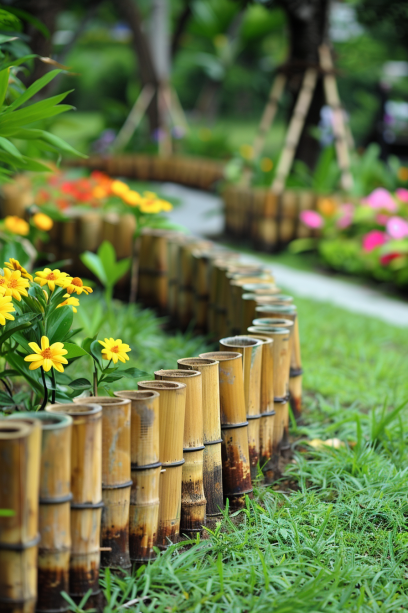
Longevity: Treat bamboo to extend its life and prevent rot.
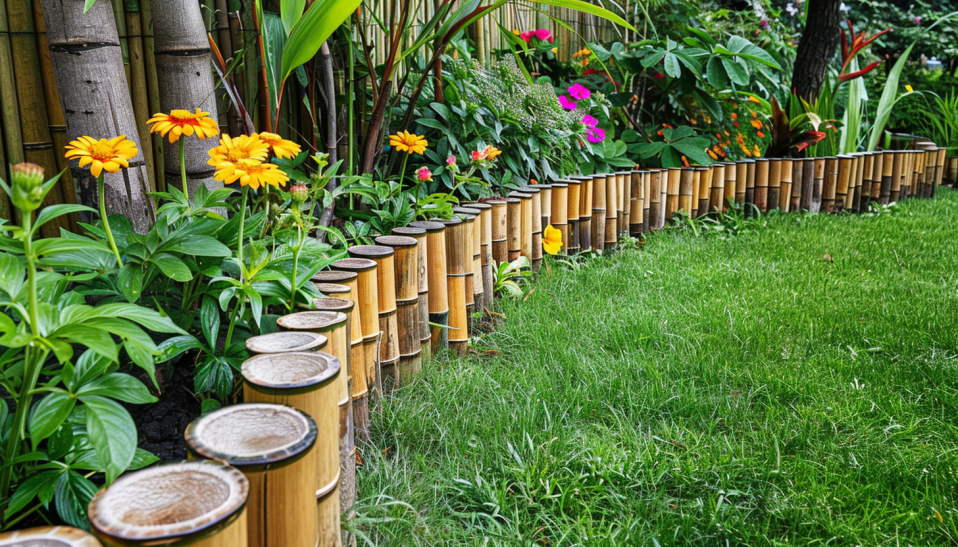
Living Borders: Use low-growing plants or grasses as a natural edging solution.
- How to Use: Popular choices include lavender, thyme, and ornamental grasses.
- Benefits: Attracts pollinators, offers a soft edge, and contributes to biodiversity.
- Maintenance: Requires regular trimming to maintain shape and control growth.
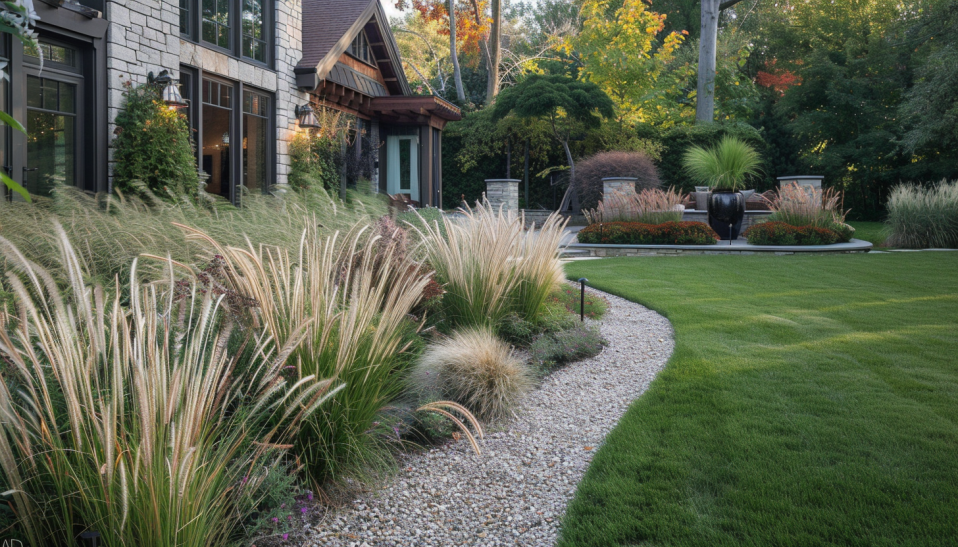
Compostable Mulch: Organic mulches like bark, leaves, or straw can create effective, eco-friendly borders.
- How to Use: Spread thick layers along garden edges, replenishing as needed.
- Benefits: Decomposes over time, enriching the soil and reducing waste.
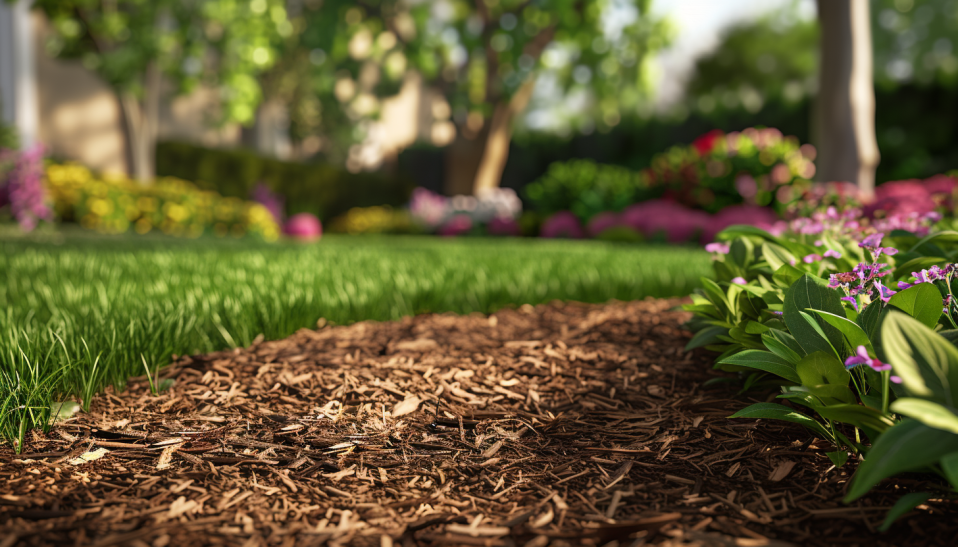
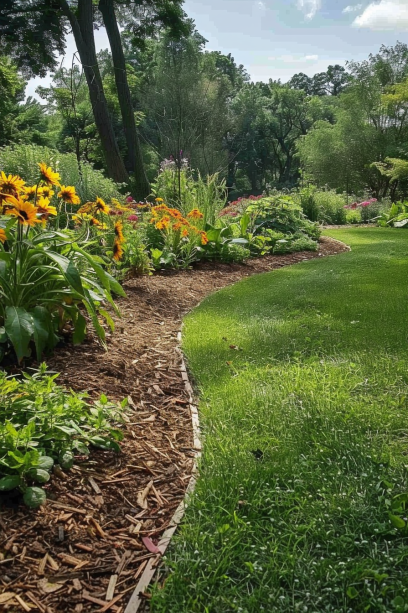
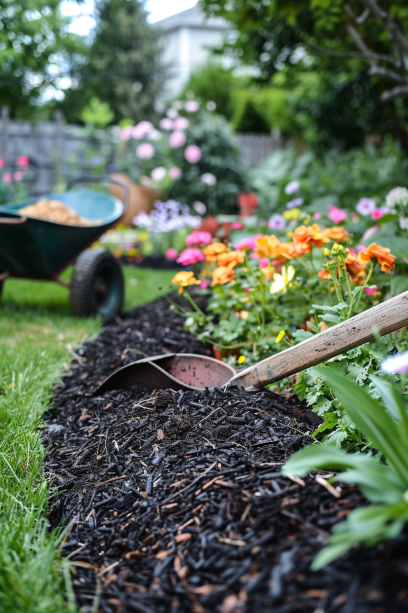
DIY vs. Professional Installation
When it comes to lawn edging, having it installed by a professional offers some significant advantages compared to a do-it-yourself project.
On the other hand, doing it yourself can be cost-effective and funny, depending on the circumstances.
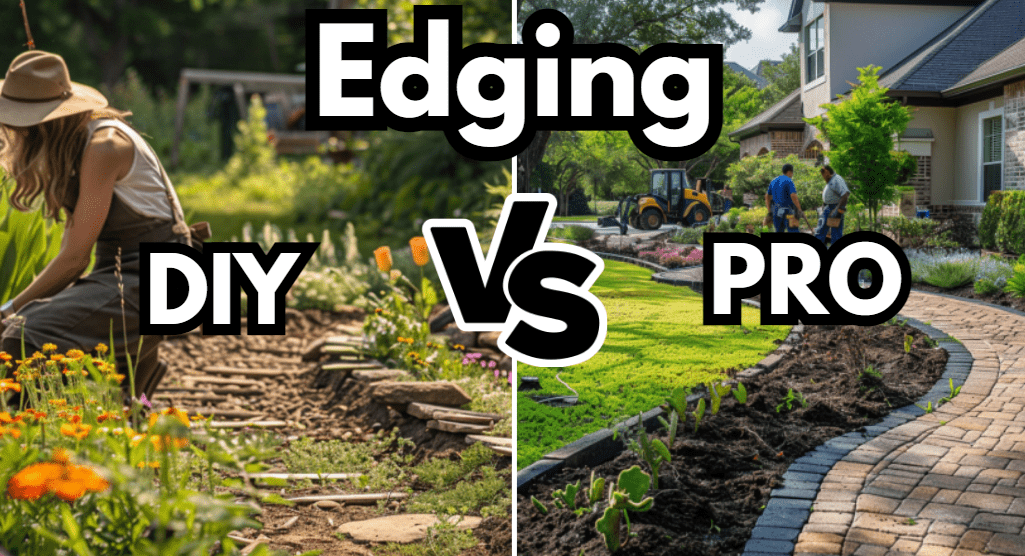
DIY Installation
Cost-Effective: DIY projects generally cost less because you save on labor expenses.
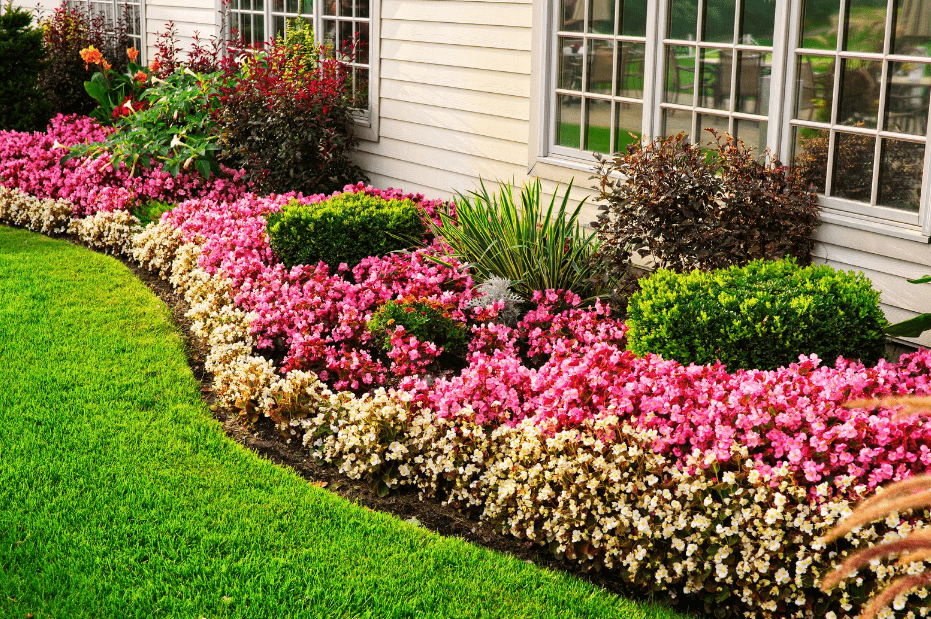
Flexibility and creativity: The process permits individual customisation and experimentation with a wide variety of materials for both the wood and the glue.
Learning Experience: Provides hands-on experience and a sense of accomplishment. (love that)
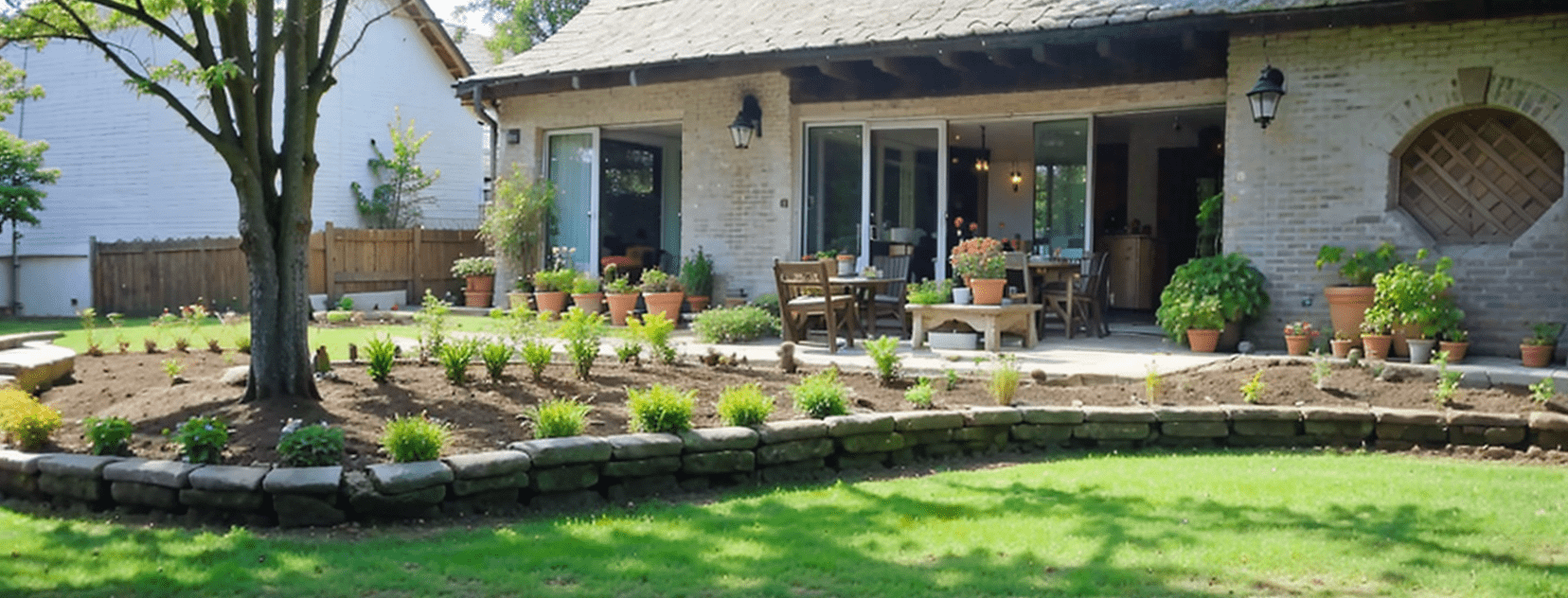
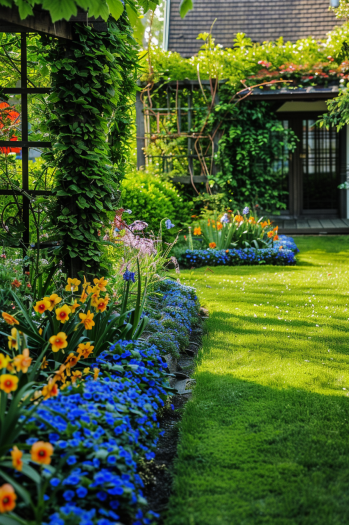
Difficulty: It takes time and effort to do and requires basic gardening and landscaping skills. Mistakes can cause more expense and sub-optimal outcomes.
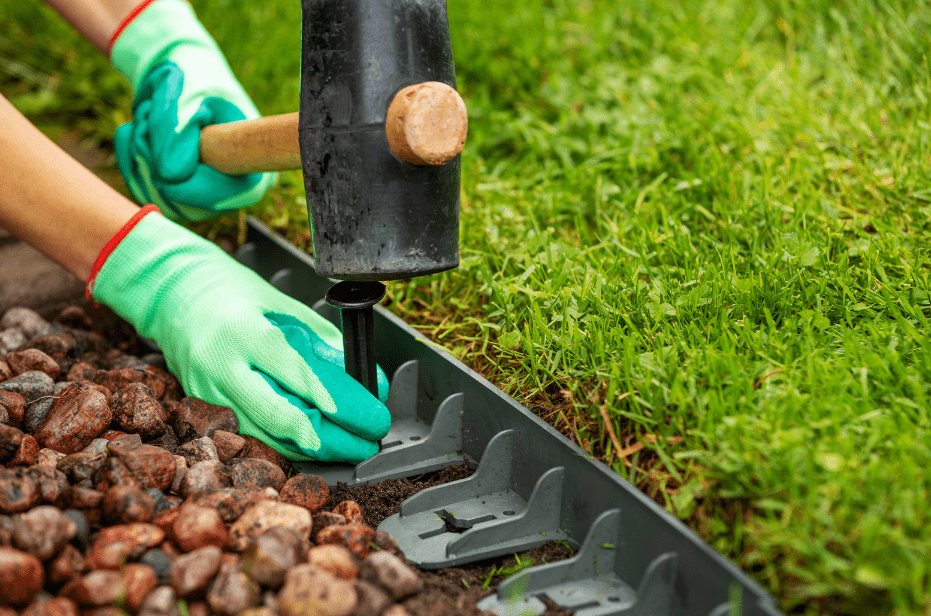
Best For: Simple edging projects, budget-conscious homeowners, and those who enjoy DIY activities =)
Professional Installation
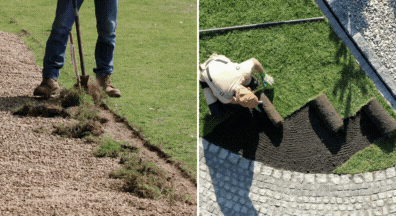
Expertise: Professionals bring experience, precision, and advanced tools to the job, ensuring high-quality results.
Time Saving: Saves you significant time and labor, especially for complex or large-scale projects.
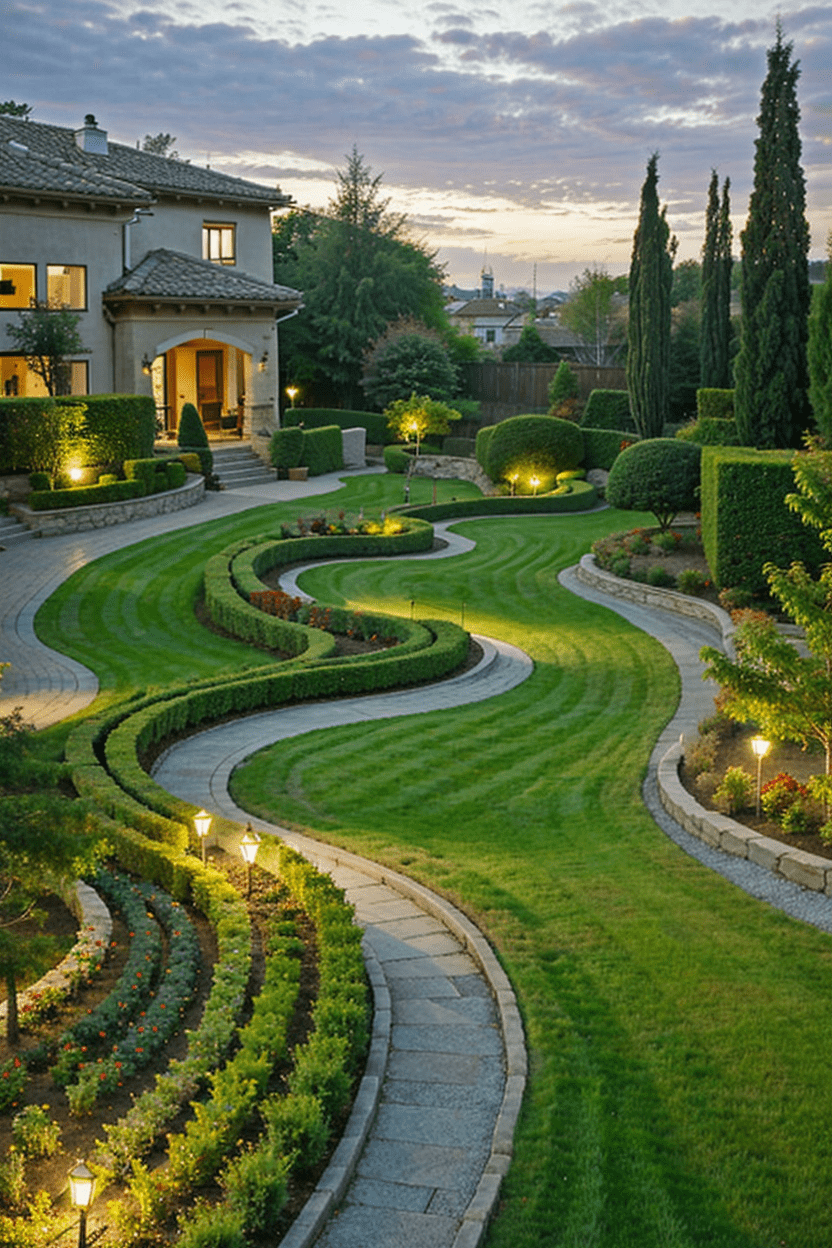
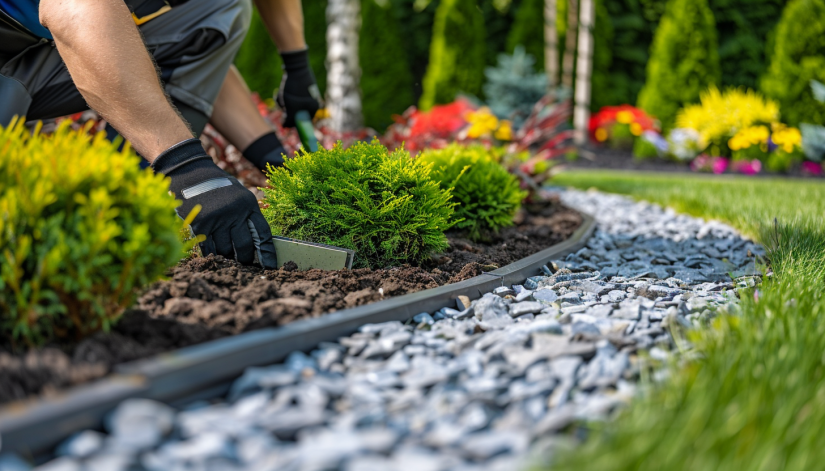
Materials Handling: You’ll have the opportunity to discuss what materials and methods the professional installers feel are best for your garden conditions.
Cons: more expensive because more labour is involved. Also, that more hands-off approach can be a downside – you might want a more hands-on creative process.
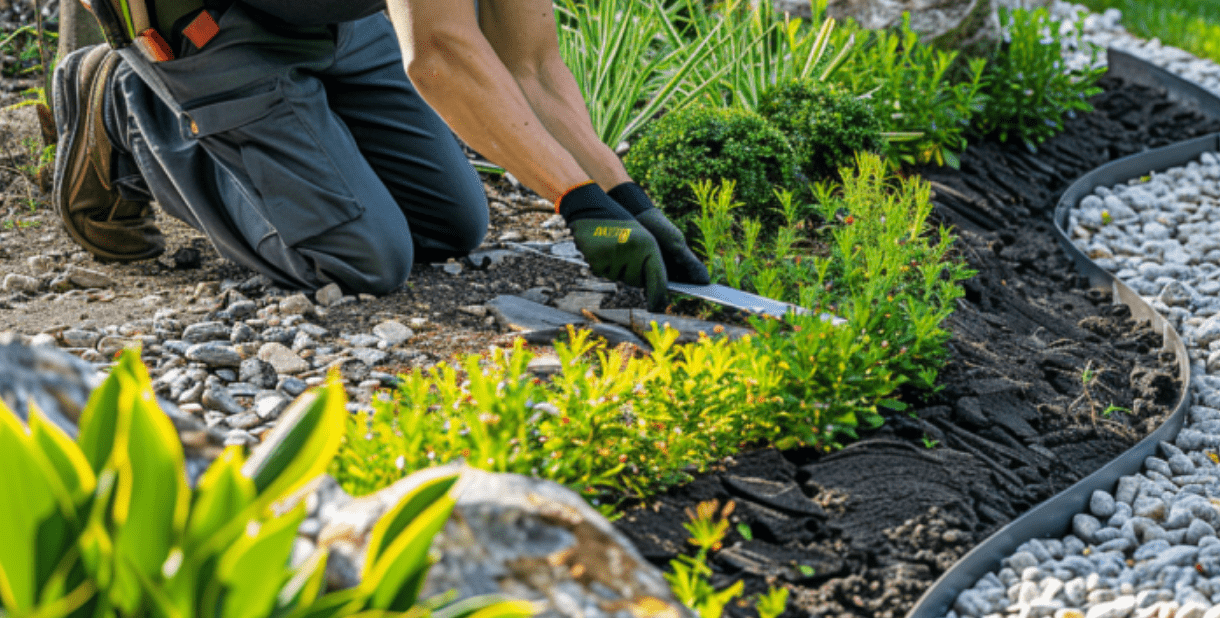
Best For: Complex shapes, large lawns, luxe materials that require special installation methods, or homeowners who don’t have time or interest in doing it themselves.
Design Considerations
Lawn edging is about much more than simply picking a material – there are important design considerations to be made if you want the edging to sit comfortably within the overall scheme of your garden.
Here are some of the key design considerations that can help ensure a cohesive and attractive outdoor space.
Garden Style – Matching Edging with the Overall Garden Theme
Modern Gardens
Characteristics: Clean lines, minimalism, and a focus on structure and form.
Edging Materials: Sleek metals like steel or aluminum, smooth concrete, and minimalist plastic designs.
Design: Strong, straight, axial edges that echo the modernist aesthetic of the garden; and perhaps monochromatic or neutral hues.
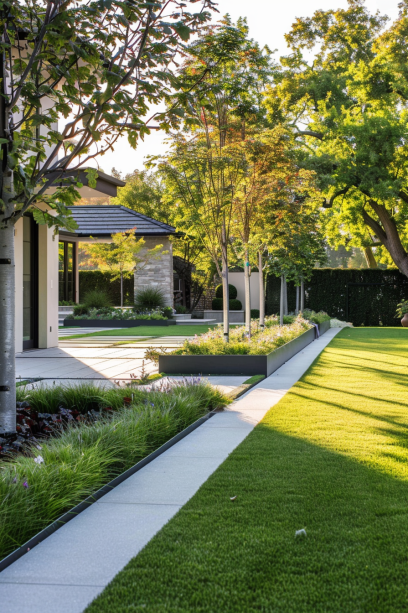
Geometric shapes, such as squares or rectangles, can also support the modernist feel.
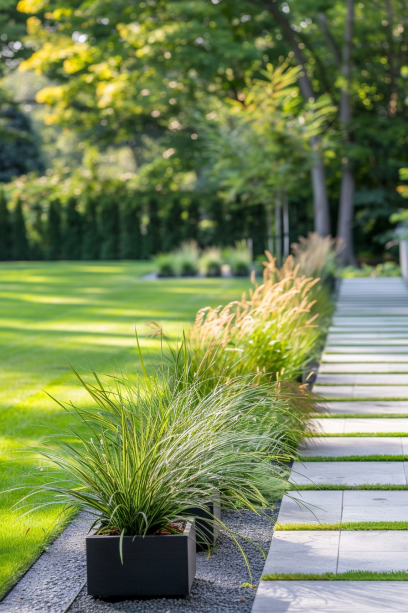
Rustic Gardens
Characteristics: Natural, weathered elements and an informal, organic layout.
Edging Materials: Natural stones, reclaimed wood logs, or rustic bricks.
Design: Rough shapes and jogs, with irregular curves, that follow the contours of the landscape. Incorporate moss or lichen-covered stones.
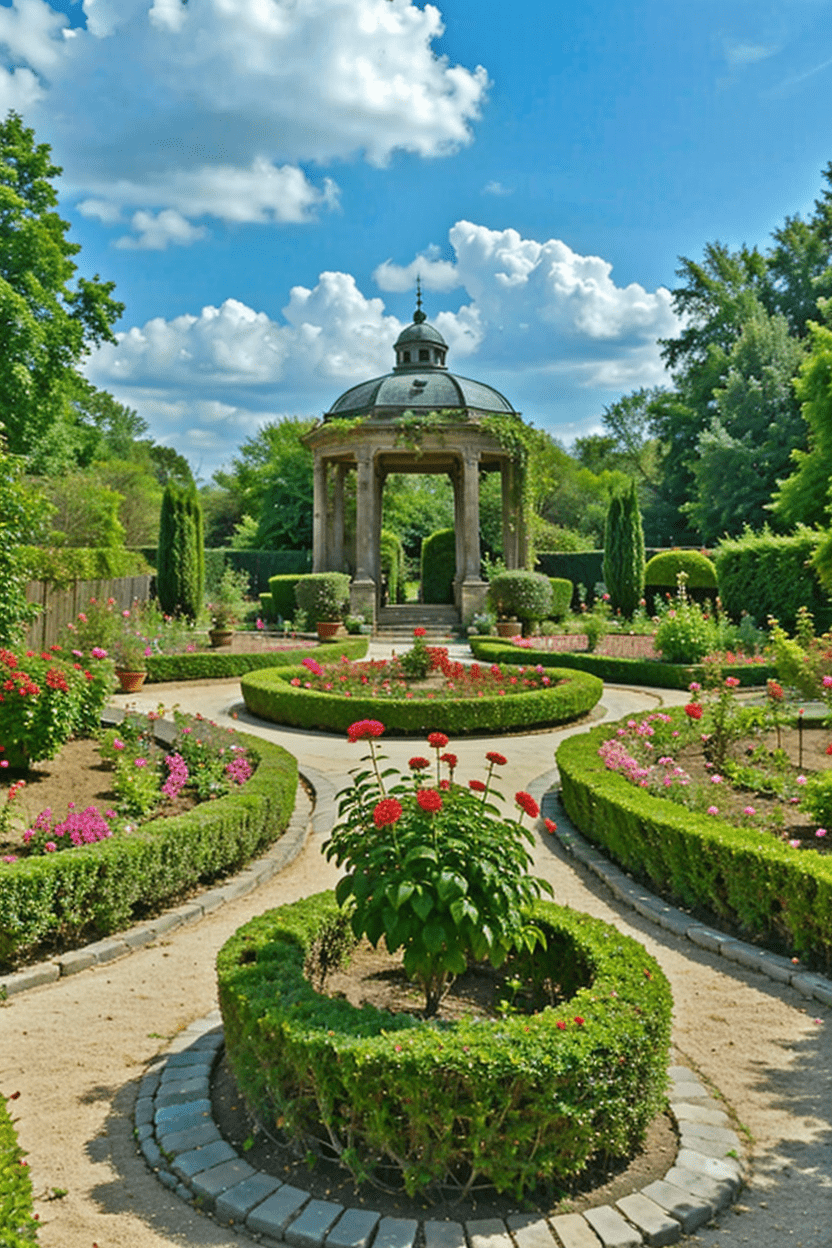
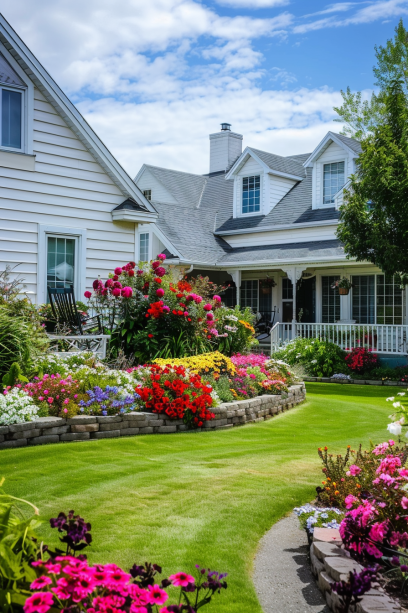
Formal Gardens
Characteristics: Symmetry, order, and often classical or historical influences.
Edging Materials: Stone or brick, wrought iron, and neatly trimmed hedges.
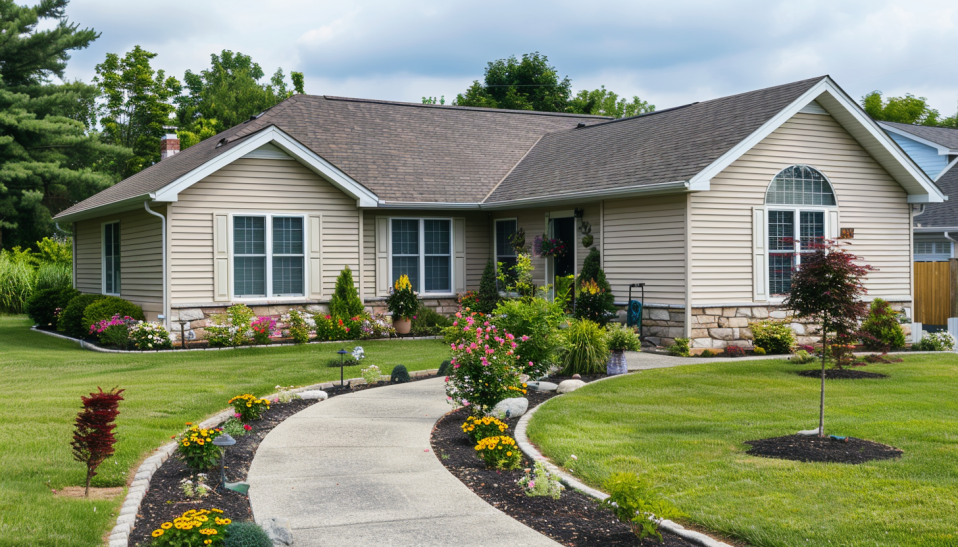
Design Ideas: Clean, defined, symmetrical patterns: straight lines or formal curves.
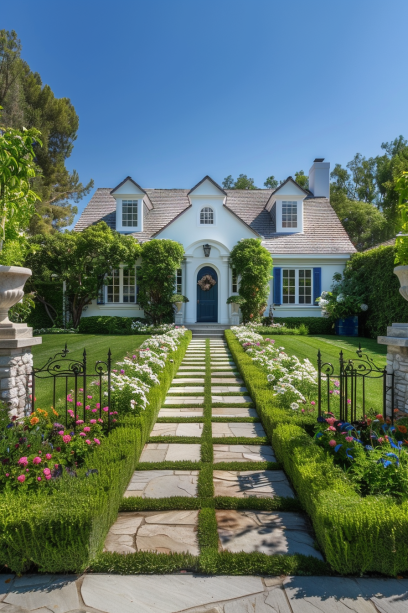
Use edging to structure and organise, and to lead the eye through the garden.
Casual Gardens
Characteristics: Relaxed and inviting with an emphasis on comfort and spontaneity.
Edging Materials: Mulch, plastic, or small stones.
Design Ideas: Simple, easy-to-maintain edging that supports a laid-back atmosphere. Informal paths and borders that meander naturally through the space.
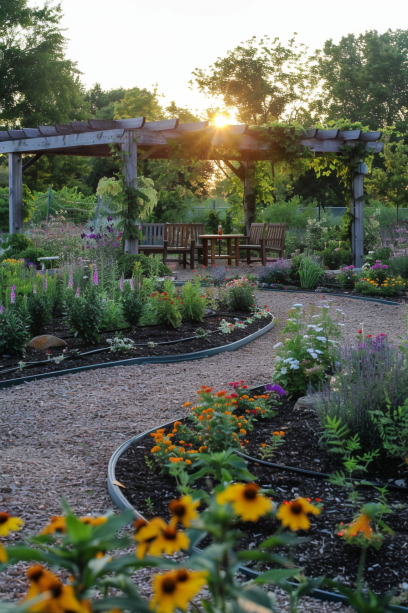
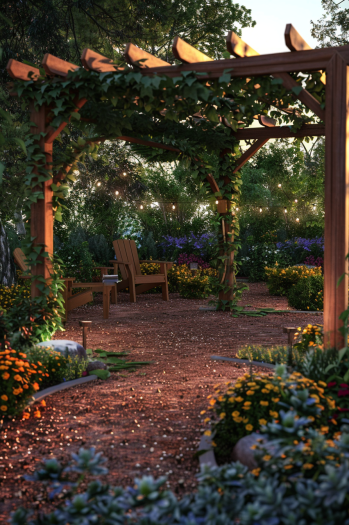
Color and Texture
Choosing Colors and Textures That Complement the Garden
Neutral Tones: Edging in grey, beige or tan can literally blend into almost any garden design, providing a subtle backdrop that lets the stars of your planting scheme shine.
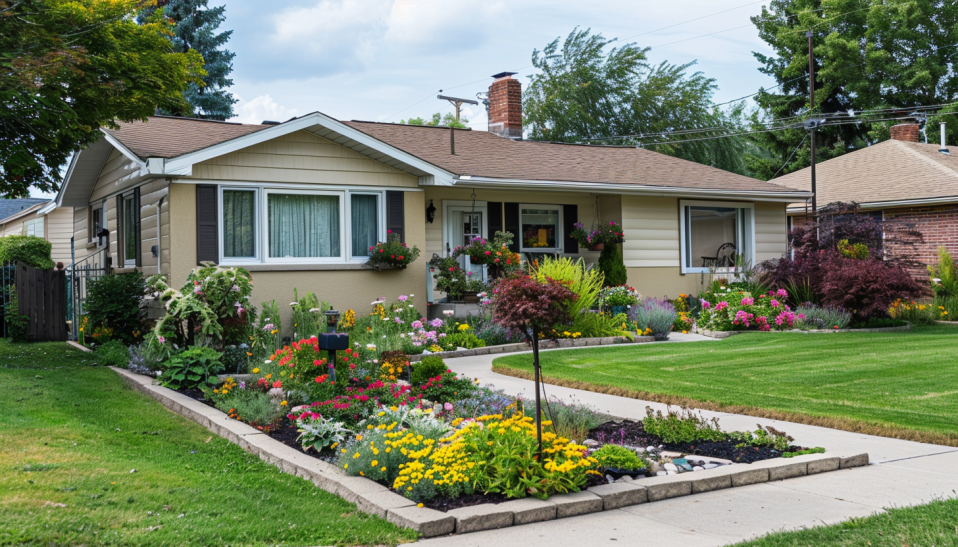
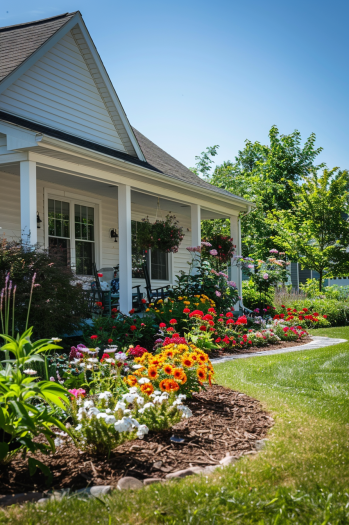
Bold Colours: Bright or contrasting edging colours can be used to provide a dramatic effect, acting as a point of interest or tying together other garden elements.
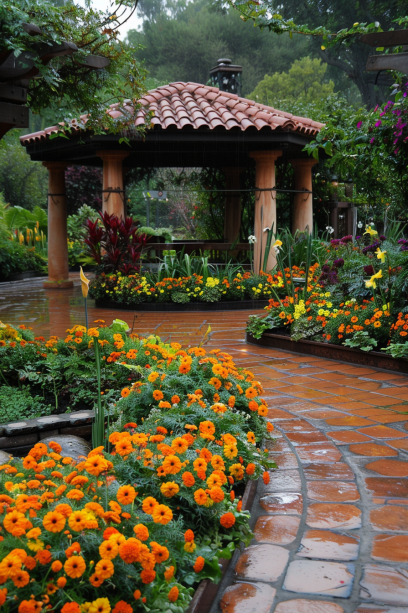
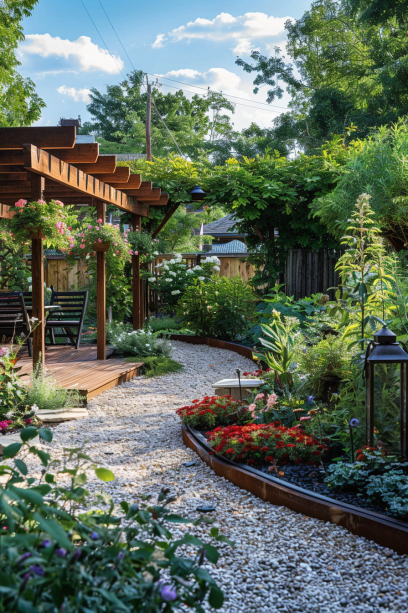
Matching Existing Elements: The colour of the edging should match other structures and elements in the garden, such as the patio, walkways or ornamentation.
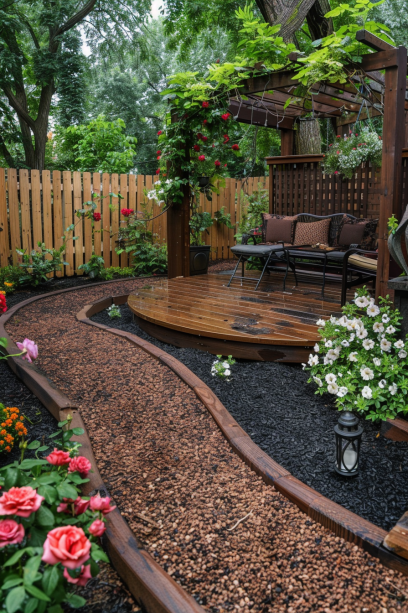
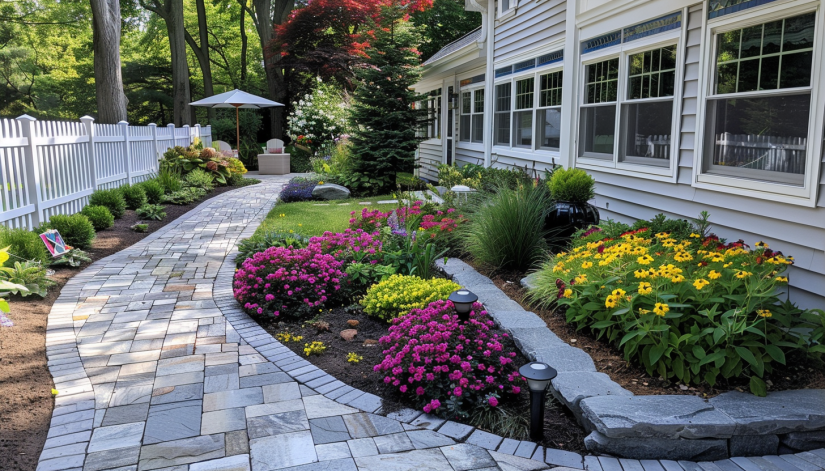
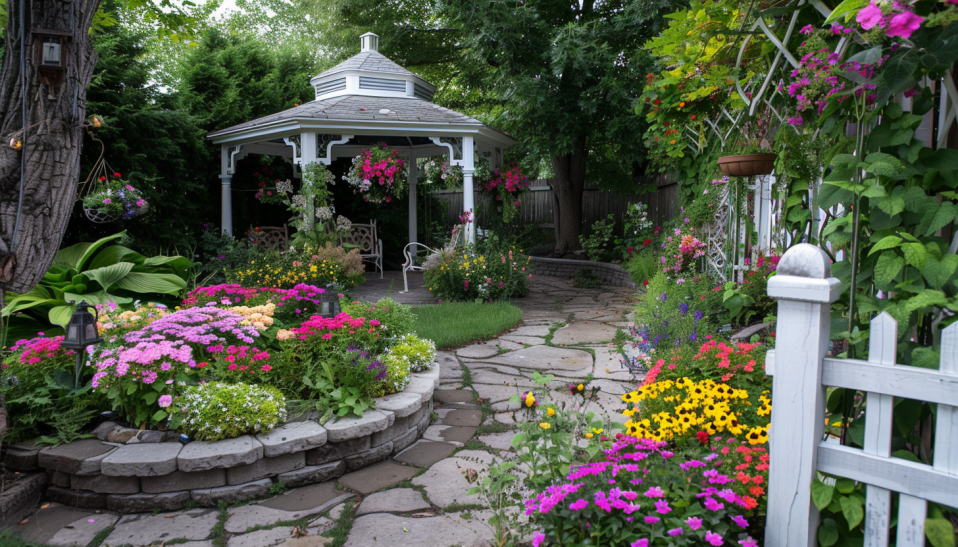
Texture Considerations:
Smooth Textures: Suitable for modern or formal gardens, smooth-edged materials like polished stone, metal, or plastic provide a clean and sophisticated look.
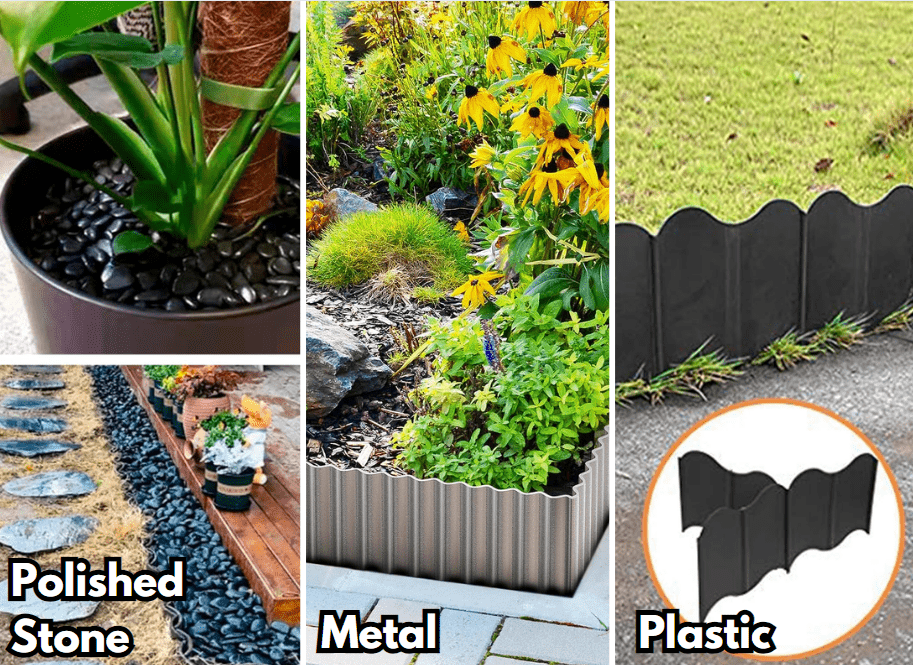
Rough Textures: Add natural, rugged textures to rustic or casual gardens. The textural contrast of some rough material, such as stone, wood (anti-corrosive material), or bark, adds visual depth to your garden.
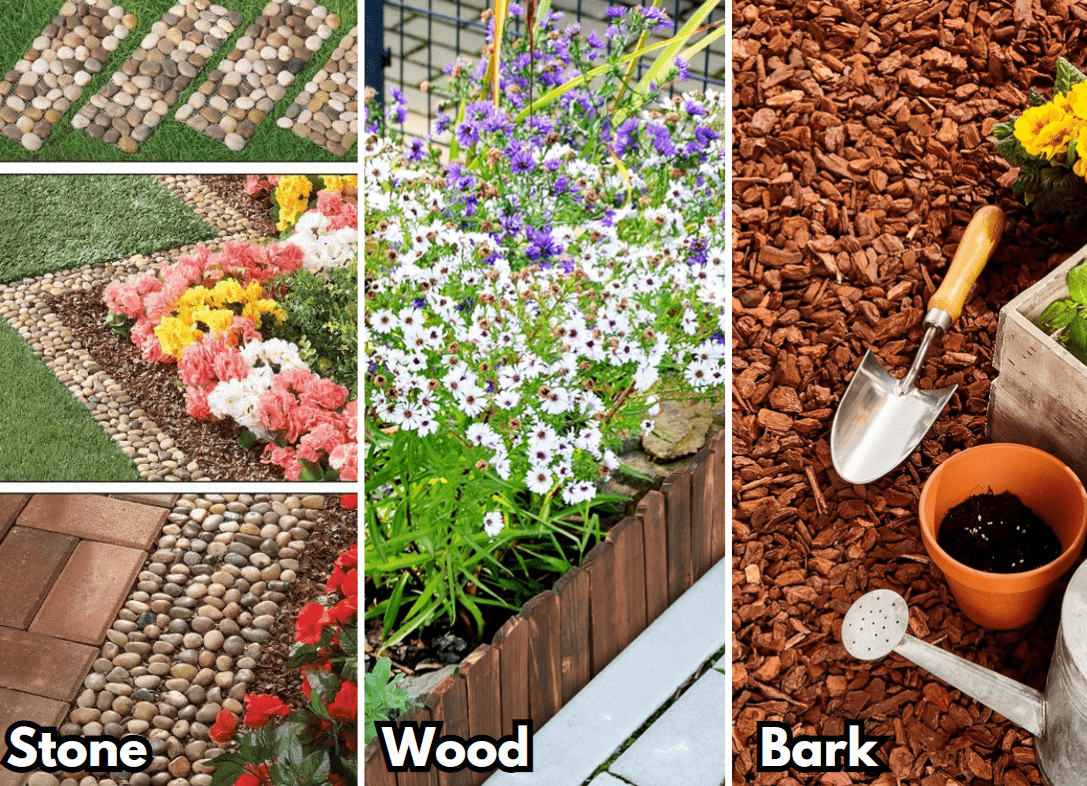
Mixed Textures: Mixing different textures in the edging can create a more complex visual effect with contrasting hard and soft sensations.
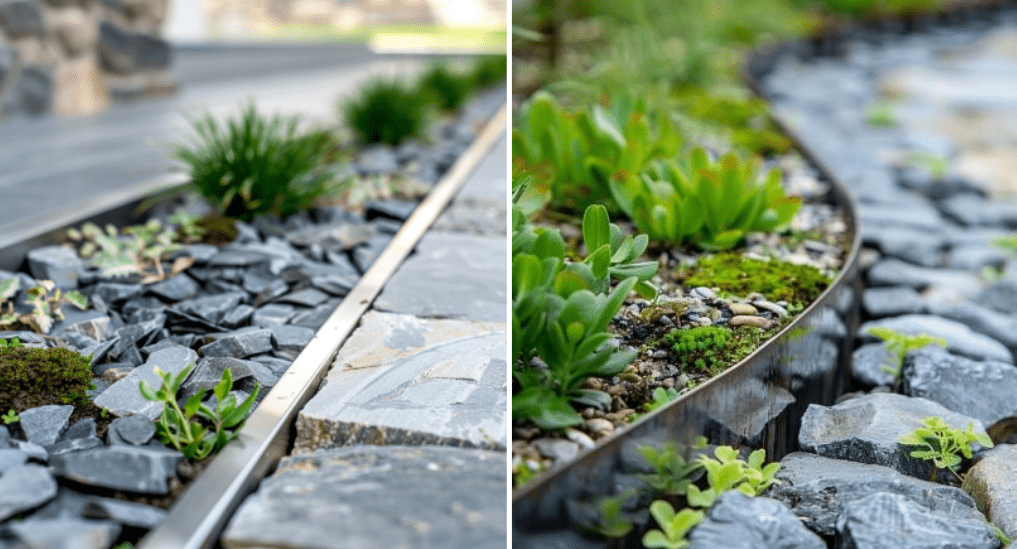
Smooth metal paired with rough stones, for instance.
Height and Width
Considering the Scale of the Edging in Relation to the Garden Size
Height
Low Edging: Best for smaller gardens or spaces where a subtle boundary is desired.
Low edging (1-3 inches high) can guide the eye without overpowering the landscape.
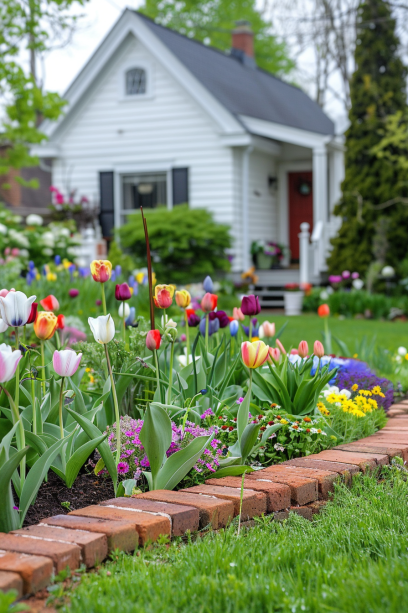
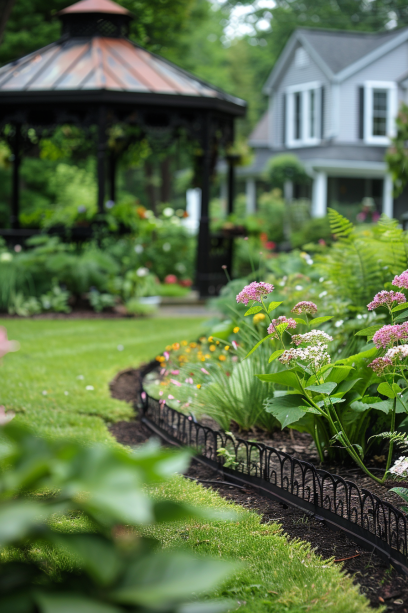
Medium Edging: Medium-sized gardens benefit from the height to provide a sense of enclosure without dominating the space.
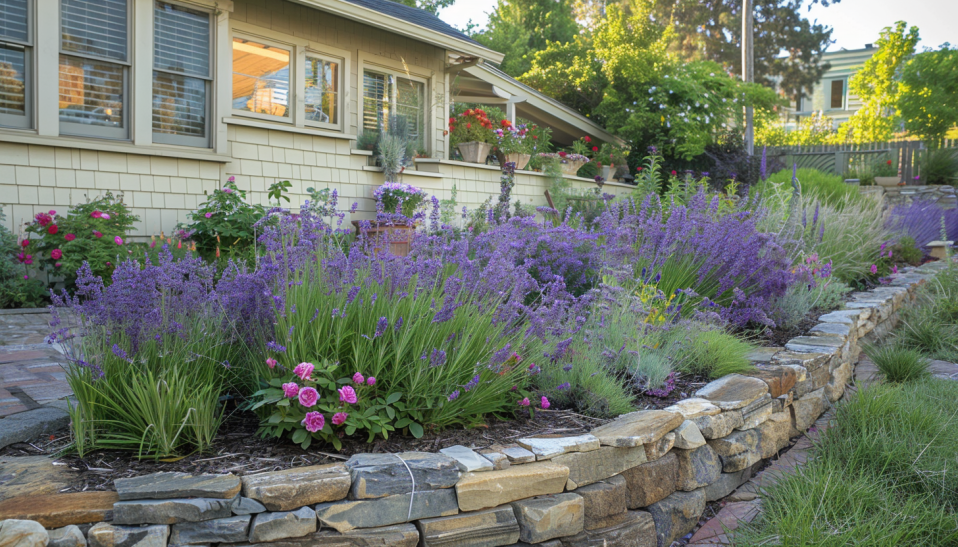
Heights of 4-6 inches work well here.
Tall Edging: Appropriate for large gardens or spaces needing a clear division between areas.
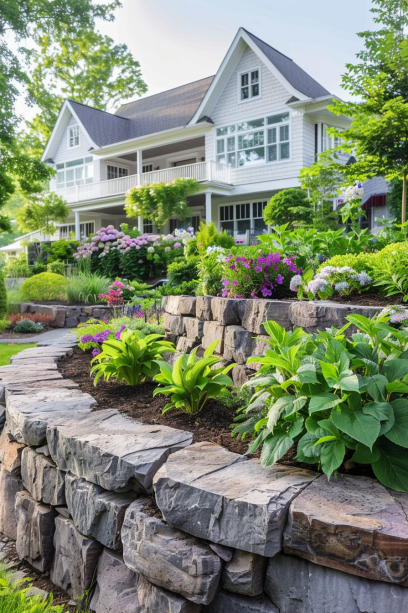
To make a statement, or to hold soil, or define the line of a raised bed, go with tall edging (7-12 inches or so).
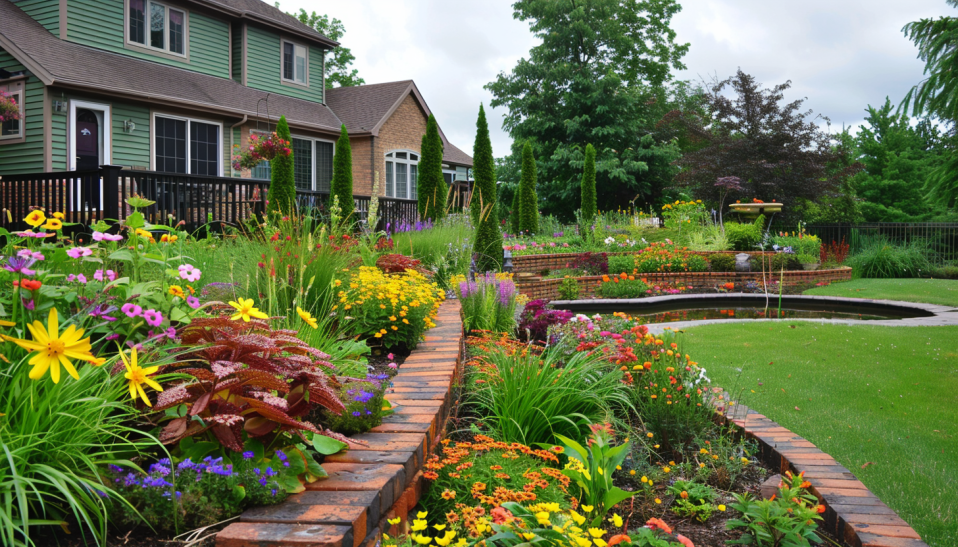
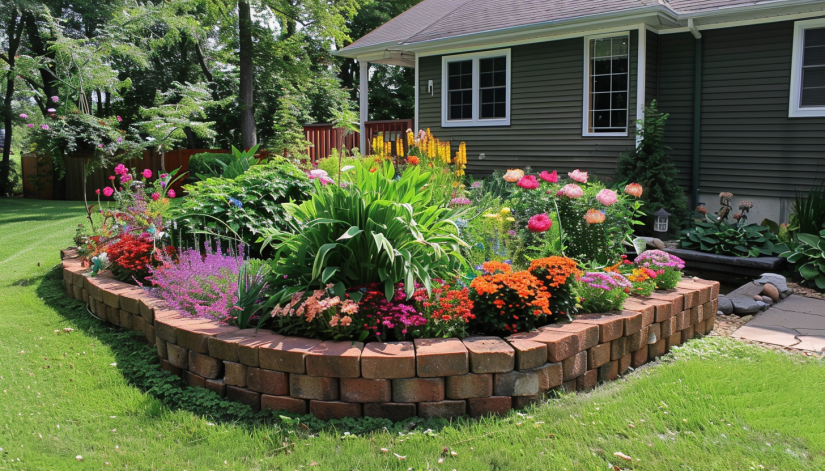
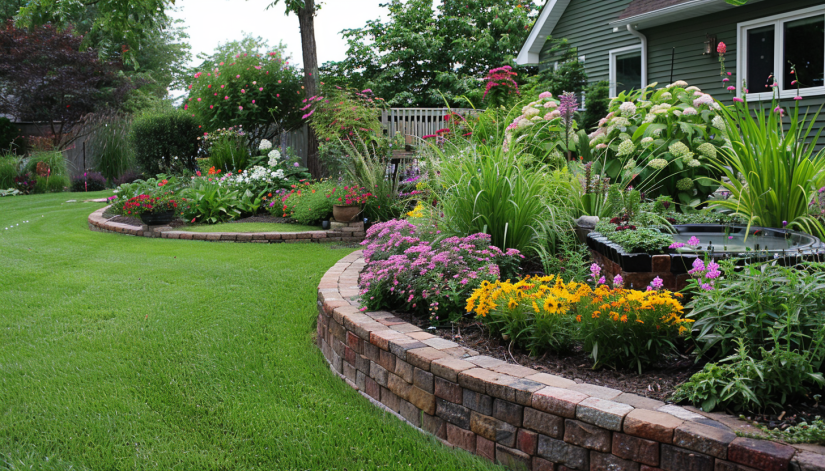
Width
Narrow Edging: Useful for tight spaces or where the edging needs to be unobtrusive, such as in formal or modern gardens.
Widths of 1-2 inches keep the focus on the plants.
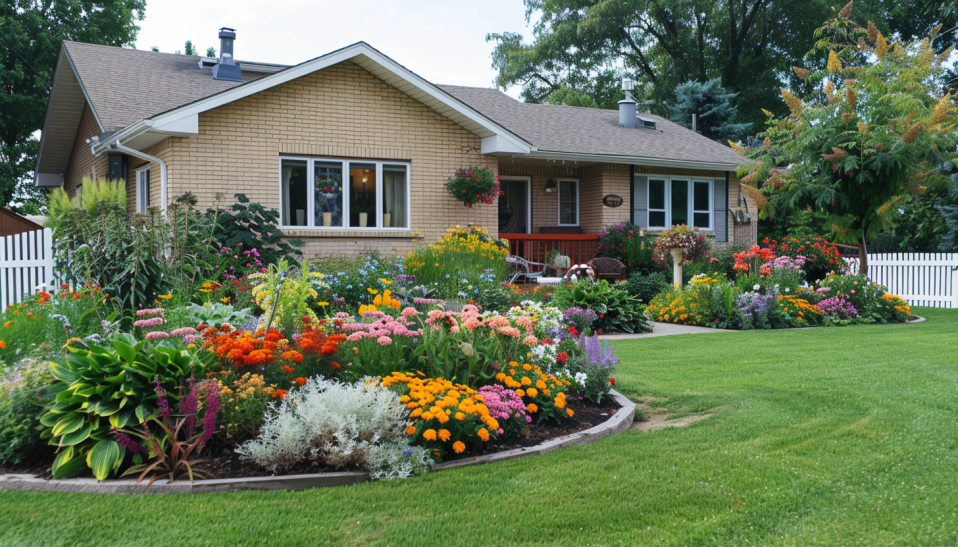
Wide Edging: Effective in larger gardens or where a prominent boundary is needed.
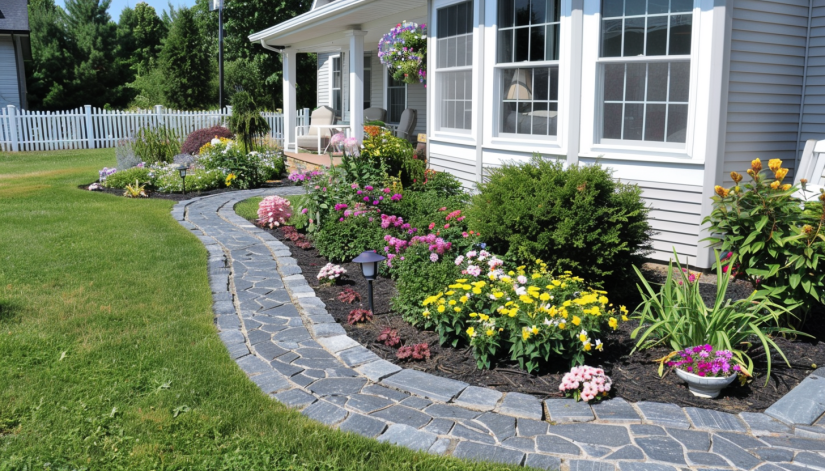
Widths of 3-6 inches or more can help anchor the landscape and make a substantial visual impact.
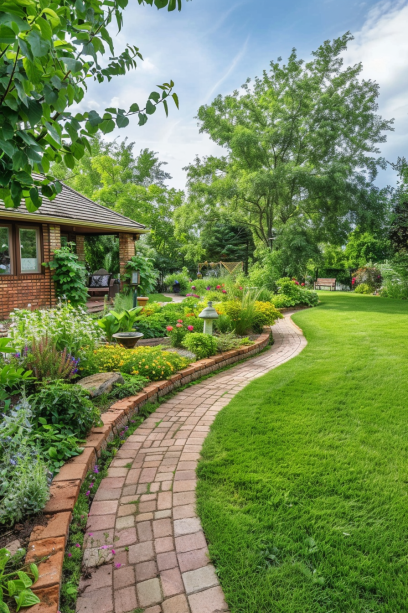
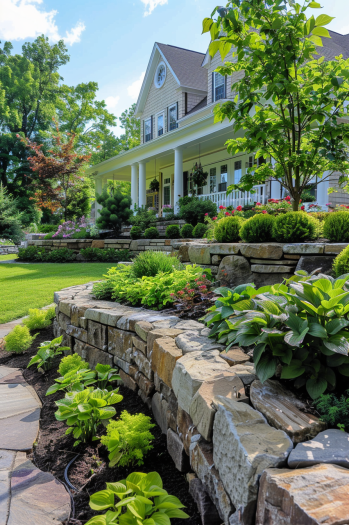
Installation Tips
Appropriate lawn edging is absolutely necessary if you want professional-looking landscaping that looks neat and boosts your garden’s beauty and functionality.
Lawn edging is the process of creating a border between a lawn and a flower bed, a pathway, a patio or similar area.
Preparation
How to measure and mark area for garden; remove unwanted grass and plants.
Define Your Boundary
Plan: Imagine a garden layout – where are its edges? Are you enclosing flower beds, separating lawn from path, or defining garden zones?
First: Choose the desired shape – use a garden hose or ropes – then change it until you’re happy with the lay out.
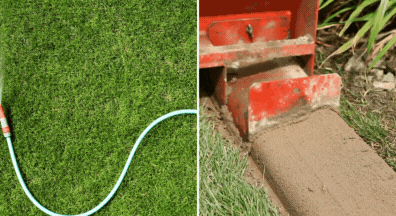
Measuring
Tools: Measuring tape — measure the length of the line where the edging will be placed. Jot down the measurements so you know how much material to buy.
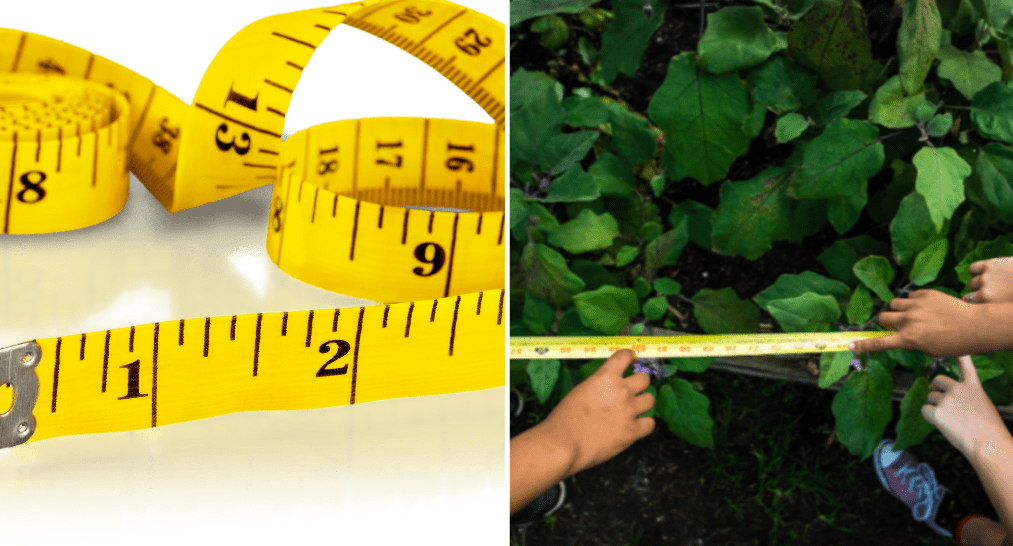
Marking
Yardsticks and string: Drive stakes at intervals along your boundary line and lay a string across them to guide you. Use a garden hose or flexible rope for curved designs.
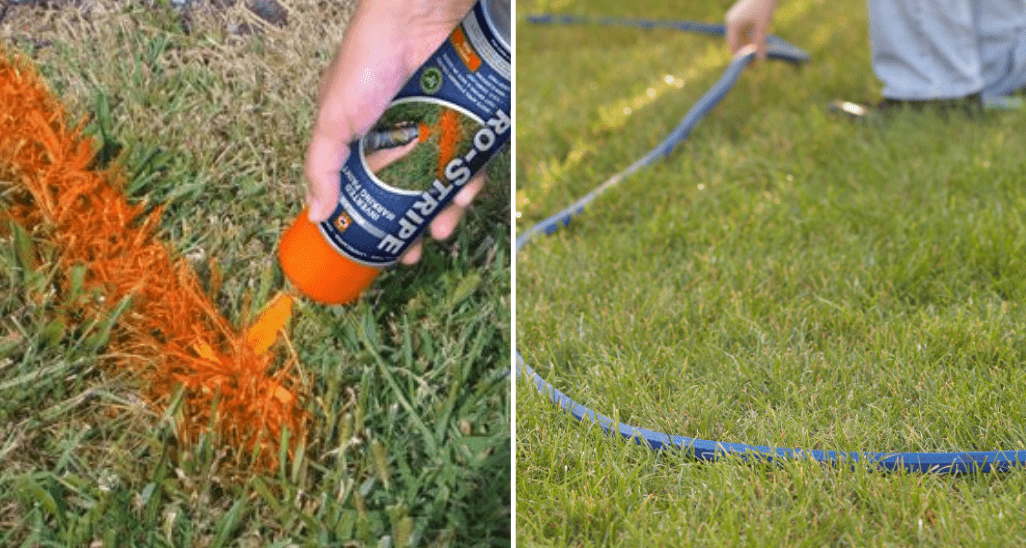
Spray paint or garden chalk: To mark the outline more permanently, spray paint or garden chalk can be used to draw the outline directly on the ground.
Clearing the Area
Dig Out the Soil: Dig out any grass, weeds, plants or shrubs in the edging path area. Cut at least 6 inches wide and deep enough so that the edging can be properly placed in the hole.
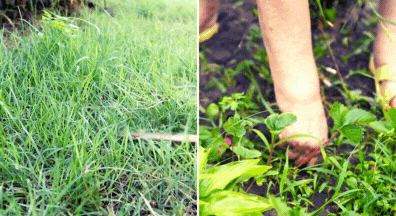
Flatten the Ground: Make sure the ground is level so that when you lay your edging material, it will have a stable base. Use a garden rake to smooth out any bumps or ridges.
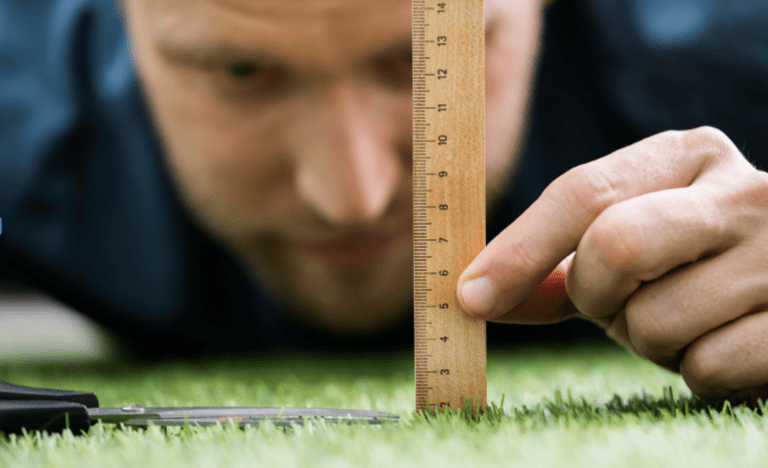
Tools and Materials Needed
List of Essential Tools and Materials for Various Types of Edging
Tools
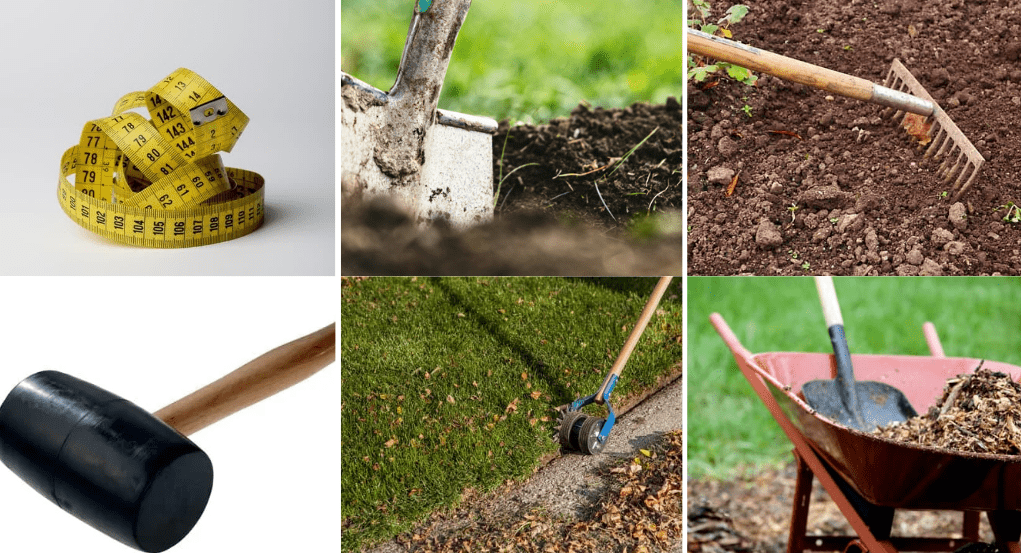
- Measuring Tape: For accurate measurements.
- Stakes and String/Marking Paint: To outline the edging path.
- Shovel or Spade: For digging and clearing the area.
- Garden Rake: To level the ground.
- Hammer or Mallet: To secure stakes and drive the edging into the ground.
- Edging Tool or Lawn Cutter: For cutting precise edges in the lawn.
- Level: To ensure the edging is evenly installed.
- Hacksaw or Cutting Tool: For cutting materials like wood, metal, or plastic to the desired length.
- Work Gloves: For hand protection during installation.
- Wheelbarrow: For transporting materials and debris.
Materials
- Edging Material: Based on your choice—natural stone, brick, wood, metal, plastic, etc.
- Gravel or Sand: For creating a base layer, particularly for stone or brick edging.

- Landscape Fabric (optional): To prevent weed growth.
- Stakes or Brackets: For securing certain types of edging (e.g., wood or plastic).
- Concrete or Mortar (optional): For securing stones or bricks in place for more permanent installations.
FAQ
What are the most popular lawn edging materials?
Brick, stone, wood, metal, plastic, and concrete are common choices.
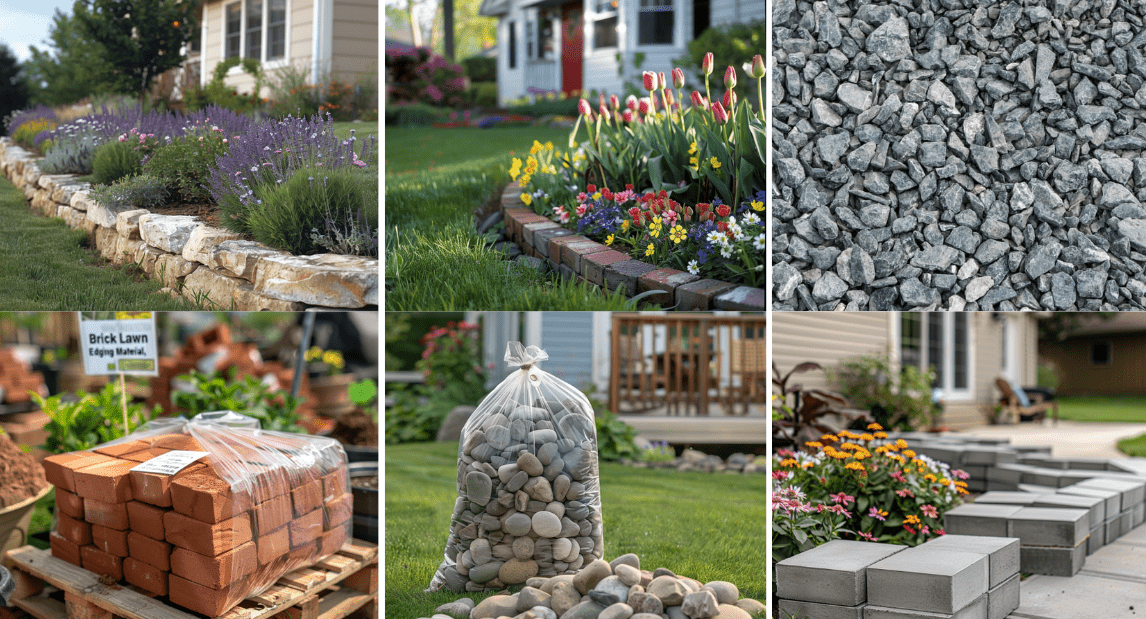
How do I choose the right edging for my yard?
Consider budget, style, maintenance, durability, and ease of installation.
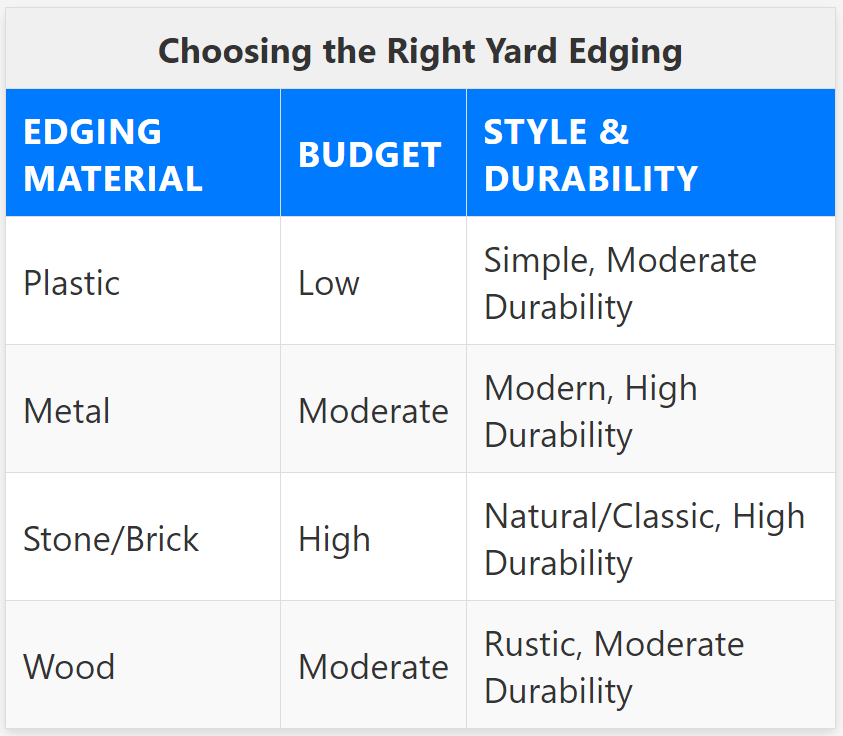
What are some best creative lawn edging ideas?
Curved borders, layered edging, geometric patterns, raised beds, and edging for pathways.
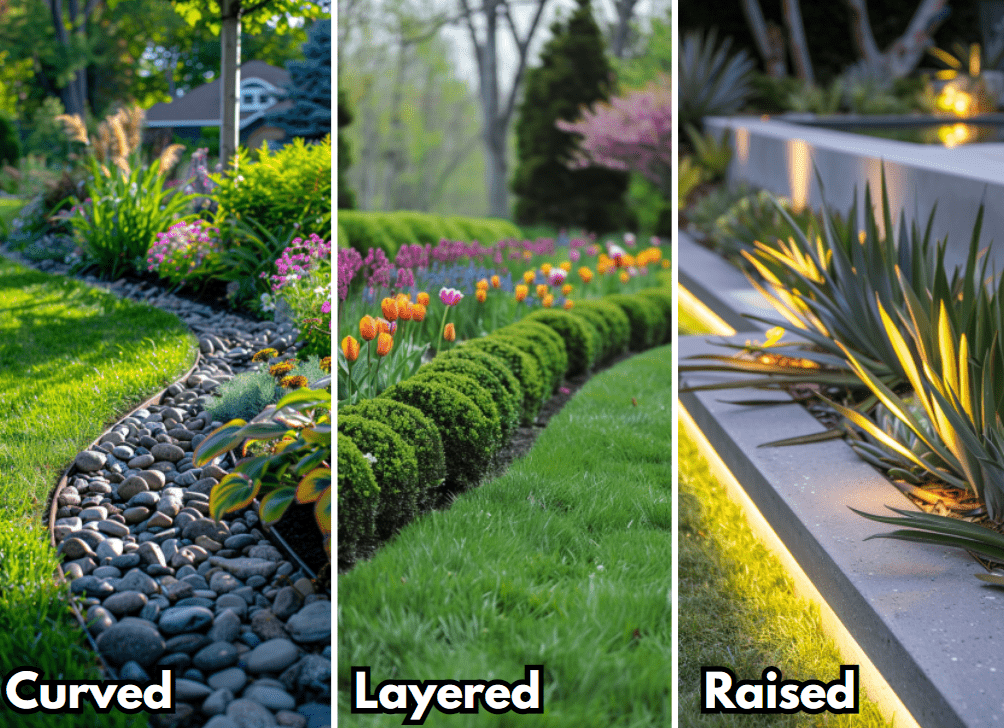
Do I need to be a professional to install lawn edging?
Many edging types can be DIY, feel free. But professional installation may be necessary for complex designs.
How do I maintain my lawn edging?
Regular weeding, cleaning, and potentially resealing or replacing depending on the material.

